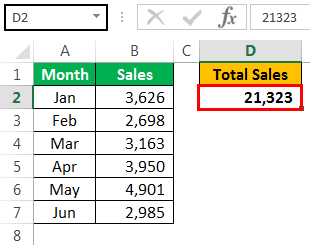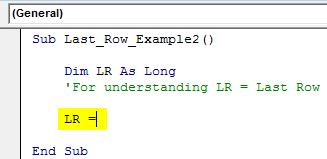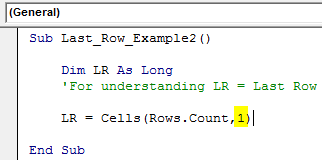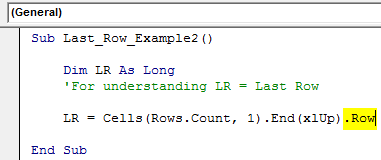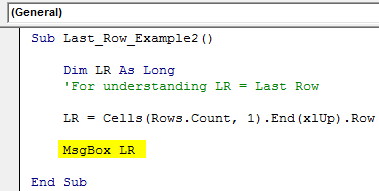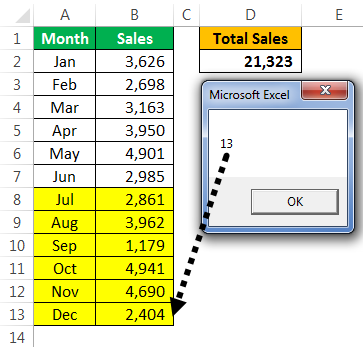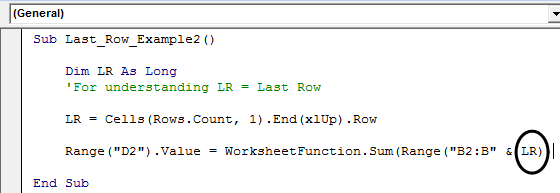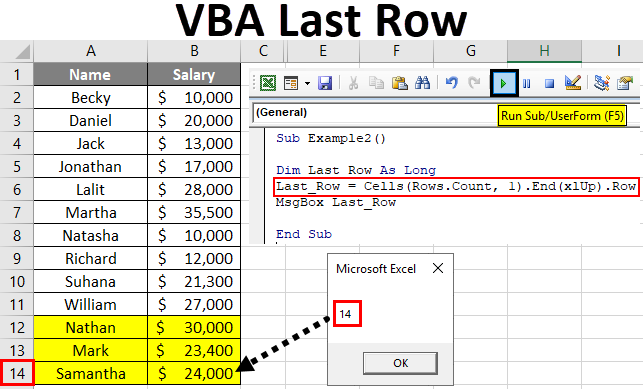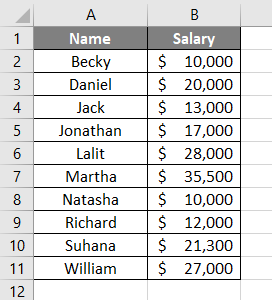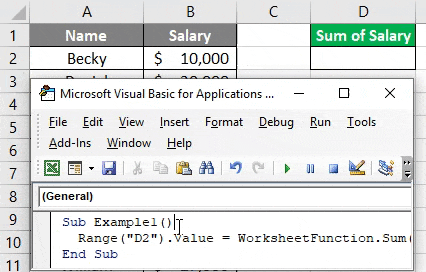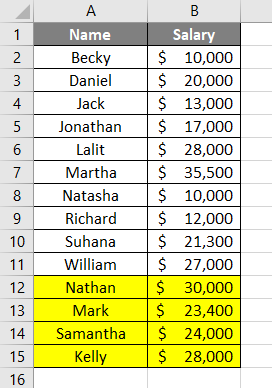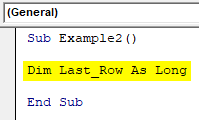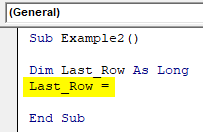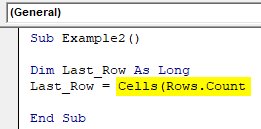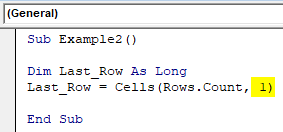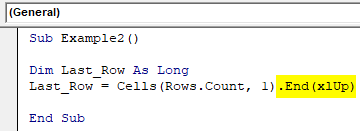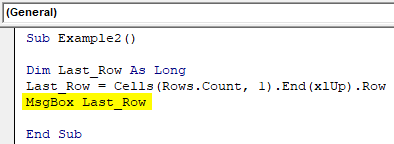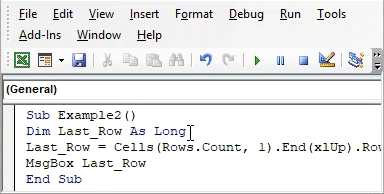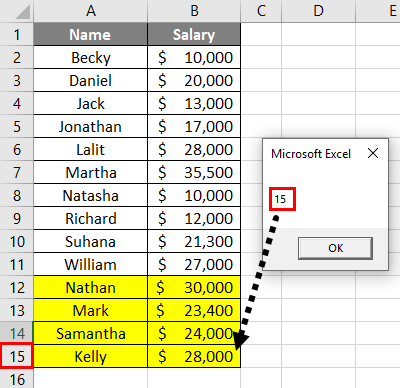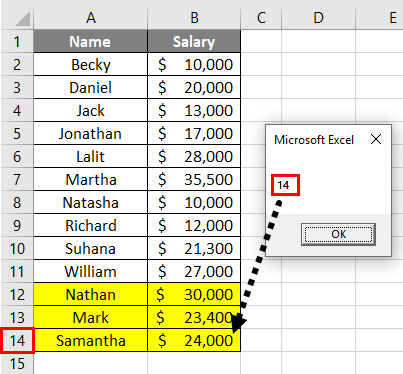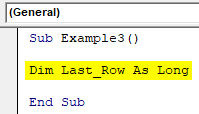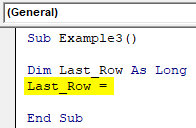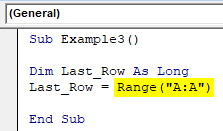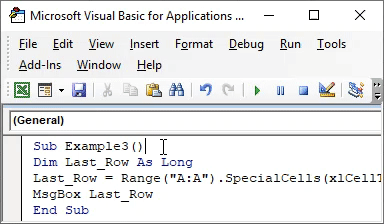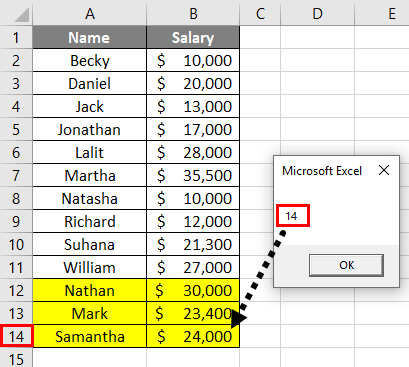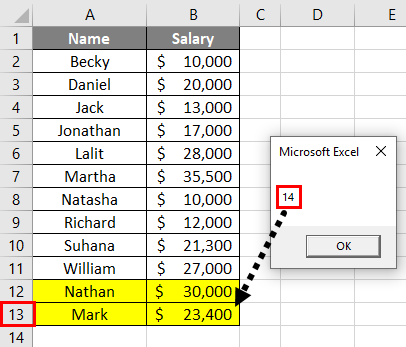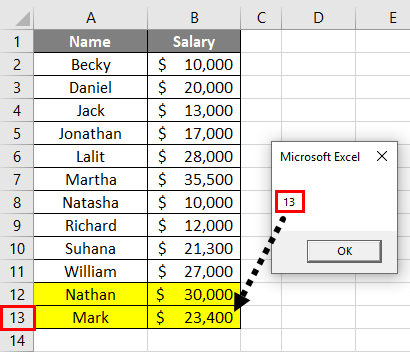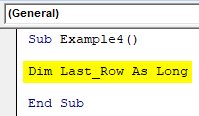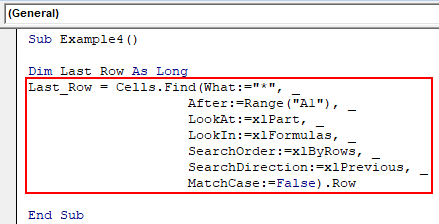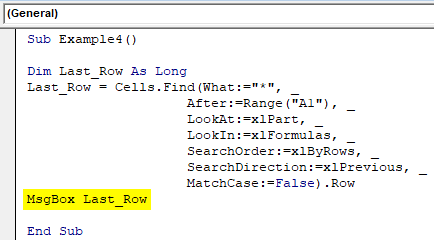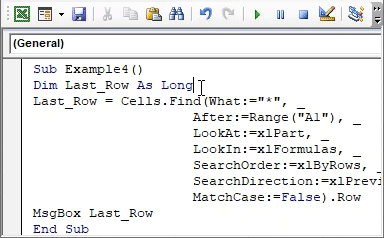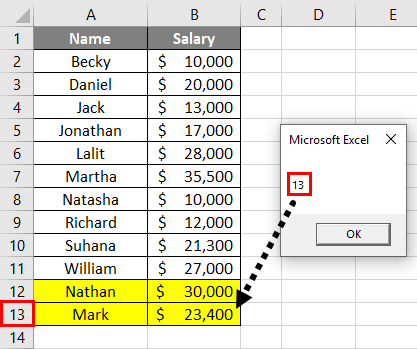|
A_nAs_tAsi_A 0 / 0 / 0 Регистрация: 21.08.2020 Сообщений: 49 |
||||
|
1 |
||||
|
21.08.2020, 10:33. Показов 3754. Ответов 3 Метки нет (Все метки)
Добрый день!
Но так ищет только до первой пустой ячейке в столбце.
0 |
|
КостяФедореев Часто онлайн 790 / 529 / 237 Регистрация: 09.01.2017 Сообщений: 1,820 |
||||
|
21.08.2020, 10:35 |
2 |
|||
|
РешениеA_nAs_tAsi_A,
1 |
|
Narimanych 2630 / 1636 / 744 Регистрация: 23.03.2015 Сообщений: 5,141 |
||||
|
21.08.2020, 10:46 |
3 |
|||
|
A_nAs_tAsi_A,
лучше….
1 |
|
6875 / 2807 / 533 Регистрация: 19.10.2012 Сообщений: 8,562 |
|
|
25.08.2020, 09:25 |
4 |
|
Но так ищет только до первой пустой ячейке в столбце. — вот вообще не так.
0 |
|
IT_Exp Эксперт 87844 / 49110 / 22898 Регистрация: 17.06.2006 Сообщений: 92,604 |
25.08.2020, 09:25 |
|
4 |
Поиск номера последней заполненной строки с помощью кода VBA Excel для таблиц, расположенных как в верхнем левом углу, так и в любом месте рабочего листа.
Номер последней заполненной строки в таблице Excel обычно используется в коде VBA для определения следующей за ней первой пустой строки для добавления новой записи. А также для задания интервала для поиска и обработки информации с помощью цикла For… Next (указание границ обрабатываемого диапазона).
Переменную, которой присваивается номер последней строки, следует объявлять как Long или Variant, например: Dim PosStr As Long. В современных версиях Excel количество строк на рабочем листе превышает максимальное значение типа данных Integer.
Таблица в верхнем левом углу
В первую очередь рассмотрим все доступные варианты поиска номера последней заполненной строки для таблиц, расположенных в верхнем левом углу рабочего листа. Такие таблицы обычно представляют собой простые базы данных в Excel, или, как их еще называют, наборы записей.
Пример таблицы с набором данных в Excel
Вариант 1
Основная формула для поиска последней строки в такой таблице, не требующая соблюдения каких-либо условий:
PosStr = Cells(1, 1).CurrentRegion.Rows.Count
Вариант 2
Ниже таблицы не должно быть никаких записей, в том числе ранее удаленных:
PosStr = ActiveSheet.UsedRange.Rows.Count
Вариант 3
В первом столбце таблицы не должно быть пропусков, а также в таблице должно быть не менее двух заполненных строк, включая строку заголовков:
PosStr = Cells(1, 1).End(xlDown).Row
Вариант 4
В первой колонке рабочего листа внутри таблицы не должно быть пропусков, а ниже таблицы в первой колонке не должно быть других заполненных ячеек:
PosStr = WorksheetFunction.CountA(Range("A:A"))
Вариант 5
Ниже таблицы не должно быть никаких записей:
PosStr = Cells.SpecialCells(xlLastCell).Row
Последняя строка любой таблицы
Последнюю заполненную строку для любой таблицы будем искать, отталкиваясь от ее верхней левой ячейки: Cells(a, b).
Вариант 1
Основная формула для поиска последней строки в любой таблице, не требующая соблюдения каких-либо условий:
PosStr = Cells(a, b).CurrentRegion.Cells(Cells(a, b).CurrentRegion.Cells.Count).Row
Вариант 2
Дополнительная формула с условием, что в первом столбце таблицы нет пустых ячеек:
PosStr = Cells(a, b).End(xlDown).Row
Если у вас на рабочем листе Excel есть записи вне таблиц, следите за тем, чтобы таблицы были окружены пустыми ячейками или пустыми ячейками и границами листа. Тогда не будет случайно внесенных заметок, примыкающих к таблицам, которые могут отрицательно повлиять на точность вычисления номера последней строки из кода VBA.
How can I determine the last row in an Excel sheet, including some blank lines in the middle?
With this function:
Function ultimaFilaBlanco(col As String) As Long
Dim lastRow As Long
With ActiveSheet
lastRow = ActiveSheet.Cells(ActiveSheet.Rows.Count, col).End(xlUp).row
End With
ultimaFilaBlanco = lastRow
End Function
And this data:
Row 1 : Value
Row 2 : Value
Row 3 : Value
Row 4 : Value
Row 5 : Value
Row 6 : White
Row 7 : Value
Row 8 : Value
Row 9 : Value
Row 10 : White
Row 11 : White
Row 12 : White
Row 13 : Value
Row 14 : White
The function returns 5, and I need 13. Any idea how to do it?
Paolo Stefan
10.1k5 gold badges48 silver badges64 bronze badges
asked Dec 3, 2012 at 15:49
4
The best way to get number of last row used is:
ActiveSheet.UsedRange.Rows.Count for the current sheet.
Worksheets("Sheet name").UsedRange.Rows.Count for a specific sheet.
To get number of the last column used:
ActiveSheet.UsedRange.Columns.Count for the current sheet.
Worksheets("Sheet name").UsedRange.Columns.Count for a specific sheet.
I hope this helps.
Abdo
answered Jun 12, 2013 at 14:19
3
ActiveSheet.UsedRange.Rows.Count + ActiveSheet.UsedRange.Rows(1).Row -1
Short. Safe. Fast. Will return the last non-empty row even if there are blank lines on top of the sheet, or anywhere else. Works also for an empty sheet (Excel reports 1 used row on an empty sheet so the expression will be 1). Tested and working on Excel 2002 and Excel 2010.
answered Dec 23, 2013 at 14:30
3
I use the following:
lastrow = ActiveSheet.Columns("A").Cells.Find("*", SearchOrder:=xlByRows, LookIn:=xlValues, SearchDirection:=xlPrevious).Row
It’ll find the last row in a specific column. If you want the last used row for any column then:
lastrow = ActiveSheet.Cells.Find("*", SearchOrder:=xlByRows, LookIn:=xlValues, SearchDirection:=xlPrevious).Row
answered Dec 3, 2012 at 17:24
Sid HollandSid Holland
2,8713 gold badges29 silver badges43 bronze badges
1
You’re really close. Try using a large row number with End(xlUp)
Function ultimaFilaBlanco(col As String) As Long
Dim lastRow As Long
With ActiveSheet
lastRow = ActiveSheet.Cells(1048576, col).End(xlUp).row
End With
ultimaFilaBlanco = lastRow
End Function
answered Dec 3, 2012 at 16:18
fbonettifbonetti
6,5823 gold badges33 silver badges32 bronze badges
2
LastRow = ActiveSheet.UsedRange.Rows.Count
CallumDA
12k6 gold badges30 silver badges52 bronze badges
answered Dec 3, 2012 at 16:19
2
The Problem is the «as string» in your function. Replace it with «as double» or «as long» to make it work. This way it even works if the last row is bigger than the «large number» proposed in the accepted answer.
So this should work
Function ultimaFilaBlanco(col As double) As Long
Dim lastRow As Long
With ActiveSheet
lastRow = ActiveSheet.Cells(ActiveSheet.Rows.Count, col).End(xlUp).row
End With
ultimaFilaBlanco = lastRow
End Function
answered Jun 14, 2013 at 12:03
user1965813user1965813
6715 silver badges16 bronze badges
If sheet contains unused area on the top, UsedRange.Rows.Count is not the maximum row.
This is the correct max row number.
maxrow = Sheets("..name..").UsedRange.Rows(Sheets("..name..").UsedRange.Rows.Count).Row
answered Jun 21, 2018 at 5:26
0
Well apart from all mentioned ones, there are several other ways to find the last row or column in a worksheet or specified range.
Function FindingLastRow(col As String) As Long
'PURPOSE: Various ways to find the last row in a column or a range
'ASSUMPTION: col is passed as column header name in string data type i.e. "B", "AZ" etc.
Dim wks As Worksheet
Dim lstRow As Long
Set wks = ThisWorkbook.Worksheets("Sheet1") 'Please change the sheet name
'Set wks = ActiveSheet 'or for your problem uncomment this line
'Method #1: By Finding Last used cell in the worksheet
lstRow = wks.Range("A1").SpecialCells(xlCellTypeLastCell).Row
'Method #2: Using Table Range
lstRow = wks.ListObjects("Table1").Range.Rows.Count
'Method #3 : Manual way of selecting last Row : Ctrl + Shift + End
lstRow = wks.Cells(wks.Rows.Count, col).End(xlUp).Row
'Method #4: By using UsedRange
wks.UsedRange 'Refresh UsedRange
lstRow = wks.UsedRange.Rows(wks.UsedRange.Rows.Count).Row
'Method #5: Using Named Range
lstRow = wks.Range("MyNamedRange").Rows.Count
'Method #6: Ctrl + Shift + Down (Range should be the first cell in data set)
lstRow = wks.Range("A1").CurrentRegion.Rows.Count
'Method #7: Using Range.Find method
lstRow = wks.Column(col).Cells.Find("*", SearchOrder:=xlByRows, LookIn:=xlValues, SearchDirection:=xlPrevious).Row
FindingLastRow = lstRow
End Function
Note: Please use only one of the above method as it justifies your problem statement.
Please pay attention to the fact that Find method does not see cell formatting but only data, hence look for xlCellTypeLastCell if only data is important and not formatting. Also, merged cells (which must be avoided) might give you unexpected results as it will give you the row number of the first cell and not the last cell in the merged cells.
answered Aug 5, 2017 at 17:23
jainashishjainashish
4,4425 gold badges38 silver badges48 bronze badges
1
ActiveSheet.UsedRange.Rows(ActiveSheet.UsedRange.Rows.count).row
ActiveSheet can be replaced with WorkSheets(1) or WorkSheets("name here")
answered Jan 29, 2018 at 21:48
18C18C
1,95410 silver badges16 bronze badges
here is my code to find the next empty row for example in first row ‘A’.
To use it for any other row just change cells(i,2 or 3 or 4 so on)
Sheets("Sheeet1").Select
for i=1 to 5000
if cells(i,1)="" then nextEmpty=i goto 20
next i
20 'continue your code here
enter code here
answered Sep 14, 2015 at 8:51
Better:
if cells(i,1)="" then
nextEmpty=i:
exit for
Vagish
2,50018 silver badges32 bronze badges
answered Dec 12, 2017 at 13:43
1
To find the last row, column, or cell you can use the range’s “End” property. The end property allows you to navigate to the end of the data range (to the last cell that is not empty). With this, there are constants that you can use to decide in which direction you want to navigate (top, bottom, left, or right).
- Define the cell or the range from where you want to navigate to the last row.
- After that, enter a dot to get the list of properties and methods.
- Select or type “End” and enter a starting parenthese.
- Use the argument that you want to use.
- Further, use the address property to get the address of the cell.
MsgBox Range("A1").End(xlDown).AddressWhen you run the above code, it shows you a message box with the row number of the last non-empty cell.

Find the Last Column using VBA
Now, let’s say you want to find the last column. In that case, instead of using “xlDown” constant, you need to use the “xlRight”, and if you want to select that cell instead of having the address then you can use the “select” method. Consider the following method.
Range("A1").End(xlToRight).Select
Find the Last Cell
By using the same method, you can also get the last cell which is a non-empty cell. To write this code, you need to know the last row and column.
Sub vba_last_row()
Dim lRow As Long
Dim lColumn As Long
lRow = Range("A1").End(xlDown).Row
lColumn = Range("A1").End(xlToRight).Column
Cells(lRow, lColumn).Select
End Sub
To understand the above code, we need to split it into three parts.

- In the FIRST part, you have declared two variables to store the row and the column number.
- In the SECOND part, you have used “End” with the “xlDown” and then the Row property to get the row number of the last, and in the same way, you have used the “End” with the “xlToRight” and then the “Column” property to get the column number of the last column.
- In the THIRD part, by using the last column number and last row number refer to the last cell and select it.
Note: If you want to select a cell in the different worksheets using the last row and last column method, you need to have that worksheet activated first.
Last Row, Column, and Cell using the Find Method
You can also use the find method with the range object to get the worksheet’s last row, column, and cell. To know the row number, here is the code:
Sub vba_last_row()
Dim iRow As Long
iRow = Cells.Find(What:="*", _
After:=Range("A1"), _
LookAt:=xlPart, _
LookIn:=xlFormulas, _
SearchOrder:=xlByRows, _
SearchDirection:=xlPrevious, _
MatchCase:=False).Row
MsgBox iRow
End SubFor column number:
Sub vba_last_row()
Dim iColumn As Long
iColumn = Cells.Find(What:="*", _
After:=Range("A1"), _
LookAt:=xlPart, _
LookIn:=xlFormulas, _
SearchOrder:=xlByColumns, _
SearchDirection:=xlPrevious, _
MatchCase:=False).Column
MsgBox iColumn
End SubTo get the cell address of the last cell.
Sub vba_last_row()
Dim iColumn As Long
Dim iRow As Long
iColumn = Cells.Find(What:="*", _
After:=Range("A1"), _
LookAt:=xlPart, _
LookIn:=xlFormulas, _
SearchOrder:=xlByColumns, _
SearchDirection:=xlPrevious, _
MatchCase:=False).Column
iRow = Cells.Find(What:="*", _
After:=Range("A1"), _
LookAt:=xlPart, _
LookIn:=xlFormulas, _
SearchOrder:=xlByRows, _
SearchDirection:=xlPrevious, _
MatchCase:=False).Row
Cells(iRow, iColumn).Address
End SubMore Tutorials
- Count Rows using VBA in Excel
- Excel VBA Font (Color, Size, Type, and Bold)
- Excel VBA Hide and Unhide a Column or a Row
- Excel VBA Range – Working with Range and Cells in VBA
- Apply Borders on a Cell using VBA in Excel
- Insert a Row using VBA in Excel
- Merge Cells in Excel using a VBA Code
- Select a Range/Cell using VBA in Excel
- SELECT ALL the Cells in a Worksheet using a VBA Code
- ActiveCell in VBA in Excel
- Special Cells Method in VBA in Excel
- UsedRange Property in VBA in Excel
- VBA AutoFit (Rows, Column, or the Entire Worksheet)
- VBA ClearContents (from a Cell, Range, or Entire Worksheet)
- VBA Copy Range to Another Sheet + Workbook
- VBA Enter Value in a Cell (Set, Get and Change)
- VBA Insert Column (Single and Multiple)
- VBA Named Range | (Static + from Selection + Dynamic)
- VBA Range Offset
- VBA Sort Range | (Descending, Multiple Columns, Sort Orientation
- VBA Wrap Text (Cell, Range, and Entire Worksheet)
- VBA Check IF a Cell is Empty + Multiple Cells
⇠ Back to What is VBA in Excel
Helpful Links – Developer Tab – Visual Basic Editor – Run a Macro – Personal Macro Workbook – Excel Macro Recorder – VBA Interview Questions – VBA Codes
In VBA, when we have to find the last row, there are many different methods. The most commonly used method is the End(XLDown) method. Other methods include finding the last value using the find function in VBA, End(XLDown). The row is the easiest way to get to the last row.
Excel VBA Last Row
If writing the code is your first progress in VBA, then making the code dynamic is your next step. Excel is full of cell referencesCell reference in excel is referring the other cells to a cell to use its values or properties. For instance, if we have data in cell A2 and want to use that in cell A1, use =A2 in cell A1, and this will copy the A2 value in A1.read more. The moment we refer to the cell, it becomes fixed. If our data increases, we need to go back to the cell reference and change the references to make the result up to date.
For an example, look at the below code.
Code:
Sub Last_Row_Example1() Range("D2").Value = WorksheetFunction.Sum(Range("B2:B7")) End Sub
The above code says in D2 cell value should be the summation of Range (“B2:B7”).
Now, we will add more values to the list.
Now, if we run the code, it will not give us the updated result. Rather, it still sticks to the old range, i.e., Range (“B2: B7”).
That is where dynamic code is very important.
Finding the last used row in the column is crucial in making the code dynamic. This article will discuss finding the last row in Excel VBA.
Table of contents
- Excel VBA Last Row
- How to Find Last Used Row in the Column?
- Method #1
- Method #2
- Method #3
- Recommended Articles
- How to Find Last Used Row in the Column?
How to Find the Last Used Row in the Column?
Below are the examples to find the last used row in Excel VBA.
You can download this VBA Last Row Template here – VBA Last Row Template
Method #1
Before we explain the code, we want you to remember how you go to the last row in the normal worksheet.
We will use the shortcut key Ctrl + down arrow.
It will take us to the last used row before any empty cell. We will also use the same VBA method to find the last row.
Step 1: Define the variable as LONG.
Code:
Sub Last_Row_Example2() Dim LR As Long 'For understanding LR = Last Row End Sub
Step 2: We will assign this variable’s last used row number.
Code:
Sub Last_Row_Example2() Dim LR As Long 'For understanding LR = Last Row LR = End Sub
Step 3: Write the code as CELLS (Rows.Count,
Code:
Sub Last_Row_Example2() Dim LR As Long 'For understanding LR = Last Row LR = Cells(Rows.Count, End Sub
Step 4: Now, mention the column number as 1.
Code:
Sub Last_Row_Example2() Dim LR As Long 'For understanding LR = Last Row LR = Cells(Rows.Count, 1) End Sub
CELLS(Rows.Count, 1) means counting how many rows are in the first column.
So, the above VBA code will take us to the last row of the Excel sheet.
Step 5: If we are in the last cell of the sheet to go to the last used row, we will press the Ctrl + Up Arrow keys.
In VBA, we need to use the end key and up, i.e., End VBA xlUpVBA XLUP is a range and property method for locating the last row of a data set in an excel table. This snippet works similarly to the ctrl + down arrow shortcut commonly used in Excel worksheets.read more
Code:
Sub Last_Row_Example2() Dim LR As Long 'For understanding LR = Last Row LR = Cells(Rows.Count, 1).End(xlUp) End Sub
Step 6: It will take us to the last used row from the bottom. Now, we need the row number of this. So, use the property ROW to get the row number.
Code:
Sub Last_Row_Example2() Dim LR As Long 'For understanding LR = Last Row LR = Cells(Rows.Count, 1).End(xlUp).Row End Sub
Step 7: Now, the variable holds the last used row number. Show the value of this variable in the message box in the VBA codeVBA MsgBox function is an output function which displays the generalized message provided by the developer. This statement has no arguments and the personalized messages in this function are written under the double quotes while for the values the variable reference is provided.read more.
Code:
Sub Last_Row_Example2() Dim LR As Long 'For understanding LR = Last Row LR = Cells(Rows.Count, 1).End(xlUp).Row MsgBox LR End Sub
Run this code using the F5 key or manually. It will display the last used row.
Output:
The last used row in this worksheet is 13.
Now, we will delete one more line, run the code, and see the dynamism of the code.
Now, the result automatically takes the last row.
That is what the dynamic VBA last row code is.
As we showed in the earlier example, change the row number from a numeric value to LR.
Code:
Sub Last_Row_Example2() Dim LR As Long 'For understanding LR = Last Row LR = Cells(Rows.Count, 1).End(xlUp).Row Range("D2").Value = WorksheetFunction.Sum(Range("B2:B" & LR)) End Sub
We have removed B13 and added the variable name LR.
Now, it does not matter how many rows you add. It will automatically take the updated reference.
Method #2
We can also find the last row in VBA using the Range objectRange is a property in VBA that helps specify a particular cell, a range of cells, a row, a column, or a three-dimensional range. In the context of the Excel worksheet, the VBA range object includes a single cell or multiple cells spread across various rows and columns.read more and special VBA cells propertyCells are cells of the worksheet, and in VBA, when we refer to cells as a range property, we refer to the same cells. In VBA concepts, cells are also the same, no different from normal excel cells.read more.
Code:
Sub Last_Row_Example3() Dim LR As Long LR = Range("A:A").SpecialCells(xlCellTypeLastCell).Row MsgBox LR End Sub
The code also gives you the last used row. For example, look at the below worksheet image.
If we run the code manually or use the F5 key result will be 12 because 12 is the last used row.
Output:
Now, we will delete the 12th row and see the result.
Even though we have deleted one row, it still shows the result as 12.
To make this code work, we must hit the “Save” button after every action. Then this code will return accurate results.
We have saved the workbook and now see the result.
Method #3
We can find the VBA last row in the used range. For example, the below code also returns the last used row.
Code:
Sub Last_Row_Example4() Dim LR As Long LR = ActiveSheet.UsedRange.Rows(ActiveSheet.UsedRange.Rows.Count).Row MsgBox LR End Sub
It will also return the last used row.
Output:
Recommended Articles
This article has been a guide to VBA Last Row. Here, we learn the top 3 methods to find the last used row in a given column, along with examples and downloadable templates. Below are some useful articles related to VBA: –
- How to Record Macros in VBA Excel?
- Create VBA Loops
- ListObjects in VBA
Dynamic VBA Code With Last Row/Column
Finding the Last Row or Last Column within your VBA code is key to ensuring your macro doesn’t break in the future.
Early on when I first began writing VBA macro code, I always needed to go back into the code and modify range references. I had created a bunch of macros to clean up and perform analysis on raw data exported from databases and the data never had the same amount of rows from one data pull to the next.
My coding skills dramatically changed the day I realized my VBA code could be dynamic and automatically determine the size of my raw data once executed. I soon came to realize the goal of coding a macro: to write it once and never touch it again.
Variability is also the greatest challenge for any VBA coder as you have to think of every possible change that could occur in the future. I have found writing VBA code that can automatically resize itself is one of the greatest things missing from most average macro user’s code.
In this article, I have compiled a list of the best methods you can use to accomplish finding the last row or column in your data range.
Prep Your Excel Data!
Keep in mind some of these methods may not give you the desired row or column number if you are not setting your spreadsheet up properly or using a well-formatted block of data.
What I mean by a “well-formatted block of data”, is a worksheet with data that starts in cell A1 and does not have any blank rows or columns in the middle of the data.
The below figure illustrates the difference.
An Example of a Poorly-Formatted Data Set
An Example of a Well-Formatted Data Set
In a data set starting in Row 4, you may need to add or subtract a numerical value depending on the method you use. If you are going to be coding for a data set that has blank rows or columns within it, always be sure to test out your code to make sure it is calculating properly.
Find the Last Cell In Spreadsheet With Data
Finding the last cell with a value in it is key to determining the last row or last column. There are a couple of different ways you can locate the last cell on your spreadsheet. Let’s take a look!
1. The Find Function Method (Best Method)
This line of VBA code will search all the cells on your sheet and return the row of the last cell with any sort of value stored in it. Because the Find function is set to search from the very bottom of the spreadsheet and upwards, this code can accommodate blank rows in your data.
Dim LastCell As Range
Set LastCell = ActiveSheet.Cells.Find(«*», SearchOrder:=xlByRows, SearchDirection:=xlPrevious)
This method ignores empty cells with formatting still in them, which is ideal if you are truly wanting the find the last cell with data in it, not necessarily the last cell that had any modifications done to it.
2. SpecialCells Method
One of the best manual ways to do this is to utilize the Go To Special dialog box.
The Go To Special dialog box has a variety of actions that can be taken to select certain cells or objections on your spreadsheet. One of those options is to select the Last Cell on the active spreadsheet.
You can get to the Go To Special dialog box by using the keyboard shortcut Ctrl + G which will open the Go To dialog box. From there you can click the Special button and you’ll have arrived at the Go To Special dialog box.
In VBA, the select actions in the Go To Special dialog box are simply called SpecialCells. By calling the SpecialCells function in VBA, you gain the same actions, though they have slightly different names. The particular action you’ll want to call is named xlCellTypeLastCell.
The below VBA code stores the last cell found on the spreadsheet with a value in it to a range variable.
Dim LastCell As Range
Set LastCell = ActiveSheet.Cells.SpecialCells(xlCellTypeLastCell)
WARNING! This method could give you unintended results as this finds the last cell with any sort of data or formatting associated with it. This means it can return an empty cell that used to have data in it or simply has any formatting changes (like a yellow cell fill color).
7 Ways To Find The Last Row With VBA
There are actually quite a few ways to determine the last row of a data set in a spreadsheet. We will walk through a number of different ways in this article. I have marked specific methods with a “Best Method” tag as these coding practices are the most bullet-proof ways to determine the last row in your spreadsheet data.
1. The Find Function Method (Best Method)
This line of VBA code will search all the cells on your sheet and return the row of the last cell with any sort of value stored in it. Because the Find function is set to search from the very bottom of the spreadsheet and upwards, this code can accommodate blank rows within your data.
Dim LastRow As Long
LastRow = ActiveSheet.Cells.Find(«*», SearchOrder:=xlByRows, SearchDirection:=xlPrevious).Row
2. SpecialCells Method
SpecialCells is a function you can call in VBA that will allow you to pinpoint certain cells or a range of cells based on specific criteria. We can use the xlCellTypeLastCell action to find the last cell in the spreadsheet and call for the cell’s row number.
Dim LastRow As Long
LastRow = ActiveSheet.Cells.SpecialCells(xlCellTypeLastCell).Row
WARNING! This method could give you unintended results as this finds the last cell with any sort of data or formatting associated with it. This means it can return an empty cell that used to have data in it or simply has any formatting changes (like a yellow cell fill color).
3. Ctrl+Shift+End Method
This line of VBA code mimics the keyboard shortcut Ctrl + Shift + End and returns the numerical value of the last row in the range.
Dim LastRow As Long
LastRow = ActiveSheet.Cells(ActiveSheet.Rows.Count, «A»).End(xlUp).Row
4. UsedRange Method
The Used Range is something that Excel stores a reference to behind the scenes. It represents the area of the spreadsheet that has values in it. The Used Range can be referenced in VBA using the UsedRange object.
You must be careful with the Used Range though , as Excel does not always update the reference in real time. Sometimes when you delete cell content the Used Range will not readjust itself right away. For this reason, it is wise to force the UsedRange object to restructure itself with your VBA code. The below VBA code example calls this restructure/refresh prior to utilizing UsedRange to pull the last row.
Dim LastRow As Long
ActiveSheet.UsedRange ‘Refresh UsedRange
LastRow = ActiveSheet.UsedRange.Rows(ActiveSheet.UsedRange.Rows.Count).Row
5. Table Object Method (Best Method)
If you are using a Table Object to store your data, you can use the Table’s name in the below VBA code to return the numerical value of how many rows are in the table.
Dim LastRow As Long
LastRow = ActiveSheet.ListObjects(«Table1»).Range.Rows.Count
6. Named Range Method
If you are using a Named Range to reference your data’s location, you can use the Range name in the below VBA code to return the numerical value of how many rows are in the Named Range.
Dim LastRow As Long
LastRow = ActiveSheet.Range(«MyNamedRange»).Rows.Count
7. Ctrl+Shift+Down Method
Dim LastRow As Long
LastRow = ActiveSheet.Range(«A1»).CurrentRegion.Rows.Count
Expand Your Range To The Last Row
After you have determined the last row, how do you use it? The vast majority of the time you are going to want to store your entire data range to a Range variable. The following code shows you how to incorporate the last row number you calculated into a Range reference.
Dim DataRange As Range
Set DataRange = Range(«A1:M» & LastRow)
7 Ways To Find The Last Column With VBA
There are actually quite a few ways to determine the last column of a data set in a spreadsheet. We will walk through a number of different ways in this article. I have marked specific methods with a “Best Method” tag as these coding practices are the most bullet-proof ways to determine the last column in your spreadsheet data.
1. The Find Function Method (Best Method)
This line of VBA code will search all the cells on your sheet and return the column of the last cell with any sort of value stored in it. Because the Find function is set to search from the very far right of the spreadsheet and then leftward, this code can accommodate blank columns within your data.
Dim LastColumn As Long
LastColumn = ActiveSheet.Cells.Find(«*», SearchOrder:=xlByColumns, SearchDirection:=xlPrevious).Column
2. SpecialCells Method
SpecialCells is a function you can call in VBA that will allow you to pinpoint certain cells or a range of cells based on specific criteria. We can use the xlCellTypeLastCell action to find the last cell in the spreadsheet and call for the cell’s column number.
Dim LastColumn As Long
LastColumn = ActiveSheet.Cells.SpecialCells(xlCellTypeLastCell).Column
WARNING! This method could give you unintended results as this finds the last cell with any sort of data or formatting associated with it. This means it can return an empty cell that used to have data in it or simply has any formatting changes (like a yellow cell fill color).
3. Ctrl+Shift+End Method
Dim LastColumn As Long
LastColumn = ActiveSheet.Cells(1, ActiveSheet.Columns.Count).End(xlToLeft).Column
4. UsedRange Method
Dim LastColumn As Long
ActiveSheet.UsedRange ‘Refresh UsedRange
LastColumn = ActiveSheet.UsedRange.Columns(ActiveSheet.UsedRange.Columns.Count).Column
5. Table Object Method (Best Method)
If you are using a Table Object to store your data, you can use the Table’s name in the below VBA code to return the numerical value of how many columns are in the table.
Dim LastColumn As Long
LastColumn = ActiveSheet.ListObjects(«Table1»).Range.Columns.Count
6. Named Range Method
Dim LastColumn As Long
LastColumn = ActiveSheet.Range(«MyNamedRange»).Columns.Count
7. Ctrl+Shift+Right Method
Dim LastColumn As Long
LastColumn = ActiveSheet.Range(«A1»).CurrentRegion.Columns.Count
How To Expand Your Range To The Last Column
After you have determined the last column, how do you use it? The vast majority of the time you are going to want to store your entire data range to a Range variable. The following code shows you how to incorporate the last column number you calculated into a Range reference.
Dim DataRange As Range
Set DataRange = Range(Cells(1, 1), Cells(100, LastColumn))
VBA Function To Find Last Row or Column
Tim provided the inspiration for a function that can return either the last row or column number through a user-defined function for a given worksheet.
An example of how you could call this function to return the last row on the active worksheet would be written as: x = LastRowColumn(ActiveSheet, «Row»)
Function LastRowColumn(sht As Worksheet, RowColumn As String) As Long
‘PURPOSE: Function To Return the Last Row Or Column Number In the Active Spreadsheet
‘INPUT: «R» or «C» to determine which direction to search
Select Case LCase(Left(RowColumn, 1)) ‘If they put in ‘row’ or column instead of ‘r’ or ‘c’.
Case «c»
LastRowColumn = sht.Cells.Find(«*», LookIn:=xlFormulas, SearchOrder:=xlByColumns, _
SearchDirection:=xlPrevious).Column
Case «r»
LastRowColumn = sht.Cells.Find(«*», LookIn:=xlFormulas, SearchOrder:=xlByRows, _
SearchDirection:=xlPrevious).Row
Case Else
LastRowColumn = 1
End Select
End Function
What Can I Do With A LastRow Or LastColumn Variable?
There are many things you can do by calculating the last row or last column of a data set. Examples could be:
-
Resizing a Pivot Table range
-
Looping through cells in a column
-
Deleting only the raw data range
There are many, many more examples of this and I’m sure you can think of a few examples yourself.
Let me know in the comments section below how you use resizing a range in your macro code! Also, if you can think of any other ways to use VBA code to find the last row or last column, post your coding method in the comments section so we can improve the current list. I look forward to reading about your experiences.
I Hope This Excel Tutorial Helped!
Hopefully, I was able to explain how you can use VBA code to find the last row or last column of your range to add dynamic capabilities to your macros. If you have any questions about these techniques or suggestions on how to improve this article, please let me know in the comments section below.
About The Author
Hey there! I’m Chris and I run TheSpreadsheetGuru website in my spare time. By day, I’m actually a finance professional who relies on Microsoft Excel quite heavily in the corporate world. I love taking the things I learn in the “real world” and sharing them with everyone here on this site so that you too can become a spreadsheet guru at your company.
Through my years in the corporate world, I’ve been able to pick up on opportunities to make working with Excel better and have built a variety of Excel add-ins, from inserting tickmark symbols to automating copy/pasting from Excel to PowerPoint. If you’d like to keep up to date with the latest Excel news and directly get emailed the most meaningful Excel tips I’ve learned over the years, you can sign up for my free newsletters. I hope I was able to provide you with some value today and hope to see you back here soon! — Chris

This VBA Last Row or Last Column Tutorial is accompanied by an Excel workbook containing the data and macros I use in the examples below. You can get immediate free access to this example workbook by subscribing to the Power Spreadsheets Newsletter.
Use the following Table of Contents to navigate to the section you’re interested in.
Related Excel VBA and Macro Tutorials
The following VBA and Macro Tutorials may help you better understand and implement the contents below:
- General VBA constructs and structures:
- Learn the basics about working with macros and VBA here.
- Learn the basic terms you should know to start working with VBA here.
- Learn how to enable or disable macros here.
- Learn how to work with the Visual Basic Editor (VBE) here.
- Learn how to work with Sub procedures here.
- Learn how to work with Function procedures (User-Defined Functions) here.
- Learn how to refer to objects here.
- Learn how to refer to cell ranges with VBA here.
- Learn how to work with R1C1-style references here.
- Learn how to work with VBA properties here.
- Learn how to work with VBA methods here.
- Learn how to declare and work with variables here.
- Learn how to work with VBA data types here.
- Learn how to use worksheet functions in VBA here.
- Learn how to work with loops here.
- Practical VBA applications and macro examples:
- Learn how to check if a cell is empty with VBA here.
- Learn how to insert rows with VBA here.
- Learn how to delete rows with VBA here.
- Learn how to delete blank or empty rows with VBA here.
- Learn how to delete columns with VBA here.
- Learn how to hide or unhide rows and columns with VBA here.
- Learn how to create named ranges with VBA here.
- Learn how to work with VBA message boxes here.
You can also:
- Find additional VBA and Macro Tutorials here.
- Find online courses about VBA and macros here.
- Find books about VBA and macros here.
- Find Excel tools and templates here.
#1: Find the Last Row in a Column Before an Empty Cell
VBA Code to Find the Last Row in a Column Before an Empty Cell
To find the last row in a column before an empty cell with VBA, use a statement with the following structure:
LastRow = CellInColumn.End(xlDown).Row
Process to Find the Last Row in a Column Before an Empty Cell
To find the last row in a column before an empty cell with VBA, follow these steps:
- Identify a cell in the column whose last row (before an empty cell) you want to find (CellInColumn). This cell should be located above the empty cell.
- Move down the column to the end of the region (End(xlDown)). This takes you to the cell immediately above the empty cell.
- Obtain the row number of that last cell immediately above the empty cell (Row).
- Assign the number of the last row to a variable (LastRow = …).
VBA Statement Explanation
Item: LastRow
Variable of the Long data type to which you assign the number of the last row found by the macro (CellInColumn.End(xlDown).Row).
Item: =
The assignment operator (=) assigns the number of the last row found by the macro (CellInColumn.End(xlDown).Row) to LastRow.
Item: CellInColumn
Range object representing a cell in the column whose last row (before an empty cell) you want to find. The cell represented by Range should be located above the empty cell.
You can usually work with, among others, the following properties to refer to this Range object:
- Worksheet.Range.
- Worksheet.Cells.
Item: End(xlDown)
The Range.End property returns a Range object representing the cell at the end of the region containing the source range (CellInColumn).
When searching for the last row in a column (before an empty cell), set the Direction parameter of the Range.End property to xlDown. xlDown specifies the direction in which to move (down).
CellInColumn.End(xlDown) is the equivalent to pressing the “Ctrl+Down Arrow” keyboard shortcut when CellInColumn is the active cell.
Item: Row
The Range.Row property returns the number of the first row of the first area in the source range.
When searching for the last row in a column (before an empty cell), the source range is the cell immediately above that empty cell (CellInColumn.End(xlDown)). Therefore, the Range.Row property returns the number of that row immediately above the applicable empty cell.
Macro Example to Find the Last Row in a Column Before an Empty Cell
The following macro (User-Defined Function) example finds the last row (before an empty cell) in the column containing the cell passed as argument (myCell).
Function lastRowInColumnBeforeBlank(myCell As Range) As Long
'Source: https://powerspreadsheets.com/
'finds the last row (before an empty cell) in the column containing myCell
'For further information: https://powerspreadsheets.com/vba-last-row-column/
'find the last row (before an empty cell) in the column containing myCell
lastRowInColumnBeforeBlank = myCell.End(xlDown).Row
End Function
Effects of Executing Macro Example to Find the Last Row in a Column Before an Empty Cell
The following image illustrates the effects of using the macro (User-Defined Function) example. As expected, Excel returns the number (16) of the last row before an empty cell (A17) in the column containing the cell passed as argument (A6).
#2: Find the Last Row Among Several Columns Before Empty Cells
VBA Code to Find the Last Row Among Several Columns Before Empty Cells
To find the last row (furthest down, before empty cells) among several columns with VBA, use a macro with the following statement structure:
OverallLastRow = 0
With Range
For Counter = .Column To .Columns(.Columns.Count).Column
ColumnLastRow = .Parent.Cells(.Row, Counter).End(xlDown).Row
If ColumnLastRow > OverallLastRow Then OverallLastRow = ColumnLastRow
Next Counter
End With
Process to Find the Last Row Among Several Columns Before Empty Cells
To find the last row (furthest down, before empty cells) among several columns with VBA, follow these steps:
- Initialize the variable that will hold the number of the overall (across all columns) last row by setting it to 0 (OverallLastRow = 0).
- Identify a cell range containing cells in the (several) columns you consider when searching for the last row before empty cells (With Range | End With). This cell range should begin above the empty cells.
- Loop through each column in Range (For Counter = .Column To .Columns(.Columns.Count).Column | Next Counter).
- Identify a cell in the column you’re currently working with (.Parent.Cells(.Row, Counter)).
- Move down the column to the end of the region (End(xlDown)). This takes you to the cell immediately above the empty cell in that column.
- Obtain the row number of that last cell immediately above the empty cell (Row).
- Assign the number of the last row in the column you’re working with to a variable (ColumnLastRow = …).
- Test if the number of the last row in the column you’re working with (ColumnLastRow) is larger than the value currently held by the variable (OverallLastRow) that holds the overall (across all columns) last row number (If ColumnLastRow > OverallLastRow).
- If the number of the last row in the column you’re working with (ColumnLastRow) is larger than the value currently held by the variable (OverallLastRow) that holds the overall (across all columns) last row number, update the value held by the variable (Then OverallLastRow = ColumnLastRow).
VBA Statement Explanation
Line #1: OverallLastRow = 0
OverallLastRow is a variable of the Long data type to which you assign the number of the last row (among several columns) found by the macro.
The assignment operator (=) initializes OverallLastRow by assigning the value of 0.
Lines #2 and #7: With Range| End With
The With… End With statement executes a series of statements (lines #3 through #6) on a single object (Range).
Range is a Range object representing a cell range containing cells in the (several) columns you consider when searching for the last row (before empty cells). This cell range should begin above those empty cells.
You can usually work with, among others, the Worksheet.Range property to refer to this Range object.
Lines #3 and #6: For Counter = .Column To .Columns(.Columns.Count).Column | Next Counter
Item: For Counter = … To … | Next Counter
The For… Next statement repeats a group of statements (lines #4 and #5) a specific number of times (.Column To .Columns(.Columns.Count).Column).
Counter is the loop counter. If you explicitly declare a variable to represent Counter, you can usually declare it as of the Long data type.
The following are the initial and final values of Counter:
- Initial value: The number of the first column in Range (.Column).
- Final value: The number of the last column in Range (.Columns(.Columns.Count).Column).
Therefore, the For… Next statement loops through all the columns in Range.
Item: .Column
The Range.Column property returns the number of the first column of the first area in the source range (Range).
When searching for the last row among several columns (before empty cells), you use the Range.Column property twice, as follows:
- .Column returns the number of the first column in Range.
- .Columns(.Columns.Count).Column returns the number of the last column in Range.
Item: .Columns(.Columns.Count)
The Range.Columns property returns a Range object representing the columns in the source range (Range).
The Range.Count property returns the number of objects in a collection. When searching for the last row among several columns (before empty cells), the Range.Count property returns the number of columns in the source range (.Columns).
Therefore:
- .Columns returns a Range object representing all columns in Range.
- .Columns.Count returns the number of columns in Range.
.Columns.Count is used as an index number of the Range.Columns property (.Columns(.Columns.Count)). In other words, .Columns(.Columns.Count) refers to the column (within Range) whose index number is equal to the number of columns in Range (.Columns.Count). This is the last column in Range.
Line #4: ColumnLastRow = .Parent.Cells(.Row, Counter).End(xlDown).Row
Item: ColumnLastRow
Variable of the Long data type to which you assign the number of the last row in the current column (column number Counter) found by the macro (.Parent.Cells(.Row, Counter).End(xlDown).Row).
Item: =
The assignment operator (=) assigns the number of the last row found by the macro in the current column (.Parent.Cells(.Row, Counter).End(xlDown).Row) to ColumnLastRow.
Item: Parent
The Range.Parent property returns the parent object of the source range (Range).
When searching for the last row among several columns, the Range.Parent property returns a Worksheet object representing the worksheet that contains Range.
Item: Cells(.Row, Counter)
The Worksheet.Cells property returns a Range object representing all the cells in the worksheet. If you specify the row and column index, the Worksheet.Cells property returns a Range object representing the cell at the intersection of the specified row and column.
When searching for the last row among several columns (before empty cells):
- .Row is the row index. The Range.Row property returns the number of the first row of the first area in the source range (Range).
- Counter is the column index and loop counter of the For… Next statement that iterates through all the columns in Range.
Therefore, the Worksheet.Cells property returns a Range object representing the cell at the intersection of:
- The first row of Range (.Row); and
- The column through which the For… Next loop is currently iterating (Counter).
Item: End(xlDown)
The Range.End property returns a Range object representing the cell at the end of the region containing the source range (Cells(.Row, Counter)).
When searching for the last row among several columns (before empty cells), set the Direction parameter of the Range.End property to xlDown. xlDown specifies the direction in which to move (down).
.Parent.Cells(.Row, Counter).End(xlDown) is the equivalent to pressing the “Ctrl+Down Arrow” keyboard shortcut when .Parent.Cells(.Row, Counter) is the active cell.
Item: Row
The Range.Row property returns the number of the first row of the first area in the source range.
When searching for the last row in a column (column number Counter, before an empty cell), the source range is the cell immediately above that empty cell (.Parent.Cells(.Row, Counter).End(xlDown)). Therefore, the Range.Row property returns the number of that row immediately above the applicable empty cell.
Line #5: If ColumnLastRow > OverallLastRow Then OverallLastRow = ColumnLastRow
Item: If … Then …
The If… Then… statement conditionally executes a group of statements (OverallLastRow = ColumnLastRow), depending on the value of an expression (ColumnLastRow > OverallLastRow).
Item: ColumnLastRow > OverallLastRow
Condition of the If… Then… statement, which evaluates to True or False as follows:
- True if ColumnLastRow is larger than (>) OverallLastRow.
- False otherwise.
Item: OverallLastRow = ColumnLastRow
Statement that is executed if the condition tested by the If… Then… statement (ColumnLastRow > OverallLastRow) returns True.
The assignment operator (=) assigns the value held by ColumnLastRow to OverallLastRow.
Macro Example to Find the Last Row Among Several Columns Before Empty Cells
The following macro (User-Defined Function) example finds the last row (before empty cells) among the columns containing the cell range passed as argument (myRange).
Function lastRowInSeveralColumnsBeforeBlank(myRange As Range) As Long
'Source: https://powerspreadsheets.com/
'finds the last row (before empty cells) in the columns containing myRange
'For further information: https://powerspreadsheets.com/vba-last-row-column/
'declare variables to represent loop counter and hold value of last row in current column
Dim iCounter As Long
Dim iColumnLastRow As Long
'initialize variable that holds the number of the (overall) last row across several columns
lastRowInSeveralColumnsBeforeBlank = 0
With myRange
'loop through each column in myRange
For iCounter = .Column To .Columns(.Columns.Count).Column
'find last row (before an empty cell) in the current column
iColumnLastRow = .Parent.Cells(.Row, iCounter).End(xlDown).Row
'if the number of the last row in the current column is larger than the row number held by lastRowInSeveralColumnsBeforeBlank, update value held by lastRowInSeveralColumnsBeforeBlank
If iColumnLastRow > lastRowInSeveralColumnsBeforeBlank Then lastRowInSeveralColumnsBeforeBlank = iColumnLastRow
Next iCounter
End With
End Function
Effects of Executing Macro Example to Find the Last Row Among Several Columns Before Empty Cells
The following image illustrates the effects of using the macro (User-Defined Function) example. As expected, Excel returns the number (17) of the last row before empty cells (A14, B15, C16, D17, E18) among the columns containing the cell range passed as argument (A6 to E6).
#3: Find the Last Row in a Column
VBA Code to Find the Last Row in a Column
To find the last row in a column with VBA, use a macro with the following statement structure:
With CellInColumn.Parent
LastRow = .Cells(.Rows.Count, CellInColumn.Column).End(xlUp).Row
End With
Process to Find the Last Row in a Column
To find the last row in a column with VBA, follow these steps:
- Identify a cell in the column whose last row you want to find (CellInColumn) and the worksheet containing this cell (CellInColumn.Parent).
- Identify the last worksheet cell in the column containing CellInColumn (.Cells(.Rows.Count, CellInColumn.Column)).
- Move up the column to the end of the region (End(xlUp)). This takes you to the last cell in the column.
- Obtain the row number of that last cell in the column (Row).
- Assign the number of the last row to a variable (LastRow = …).
VBA Statement Explanation
Lines #1 and #3: With CellInColumn.Parent | End With
Item: With … | End With
The With… End With statement executes a series of statements (line #2) on a single object (CellInColumn.Parent).
Item: CellInColumn
Range object representing a cell in the column whose last row you want to find.
You can usually work with, among others, the following properties to refer to this Range object:
- Worksheet.Range.
- Worksheet.Cells.
Item: Parent
The Range.Parent property returns the parent object of the source range (CellInColumn).
When searching for the last row in a column, the Range.Parent property returns a Worksheet object representing the worksheet that contains CellInColumn.
Line #2: LastRow = .Cells(.Rows.Count, CellInColumn.Column).End(xlUp).Row
Item: LastRow
Variable of the Long data type to which you assign the number of the last row found by the macro (.Cells(.Rows.Count, CellInColumn.Column).End(xlUp).Row).
Item: =
The assignment operator (=) assigns the number of the last row found by the macro (.Cells(.Rows.Count, CellInColumn.Column).End(xlUp).Row) to LastRow.
Item: .Cells(.Rows.Count, CellInColumn.Column)
The Worksheet.Cells property returns a Range object representing all the cells in the worksheet. If you specify the row and column index, the Worksheet.Cells property returns a Range object representing the cell at the intersection of the specified row and column.
When searching for the last row in a column:
- .Rows.Count is the row index and returns the number of the last row in the worksheet (CellInColumn.Parent). For these purposes:
- The Worksheet.Rows property returns a Range object representing all rows on the worksheet (CellInColumn.Parent).
- The Range.Count property returns the number of objects in a collection. When searching for the last row in a column, the Range.Count property returns the number of rows in the worksheet (CellInColumn.Parent).
- CellInColumn.Column is the column index and returns the number of the column containing CellInColumn. For these purposes, the Range.Column property returns the number of the first column of the first area in the source range (CellInColumn).
Therefore, the Worksheet.Cells property returns a Range object representing the cell at the intersection of:
- The last row of the worksheet (.Rows.Count); and
- The column containing CellInColumn (CellInColumn.Column).
Item: End(xlUp)
The Range.End property returns a Range object representing the cell at the end of the region containing the source range (.Cells(.Rows.Count, CellInColumn.Column)).
When searching for the last row in a column, set the Direction parameter of the Range.End property to xlUp. xlUp specifies the direction in which to move (up).
.Cells(.Rows.Count, CellInColumn.Column).End(xlUp) is the equivalent to pressing the “Ctrl+Up Arrow” keyboard shortcut when Cells(.Rows.Count, CellInColumn.Column) is the active cell.
Item: Row
The Range.Row property returns the number of the first row of the first area in the source range.
When searching for the last row in a column, the source range is the last cell in the column (.Cells(.Rows.Count, CellInColumn.Column).End(xlUp)). Therefore, the Range.Row property returns the number of that last row.
Macro Example to Find the Last Row in a Column
The following macro (User-Defined Function) example finds the last row in the column containing the cell passed as argument (myCell).
Function lastRowInColumn(myCell As Range) As Long
'Source: https://powerspreadsheets.com/
'finds the last row in the column containing myCell
'For further information: https://powerspreadsheets.com/vba-last-row-column/
'identify worksheet containing myCell
With myCell.Parent
'find the last row in the column containing myCell
lastRowInColumn = .Cells(.Rows.Count, myCell.Column).End(xlUp).Row
End With
End Function
Effects of Executing Macro Example to Find the Last Row in a Column
The following image illustrates the effects of using the macro (User-Defined Function) example. As expected, Excel returns the number (25) of the last row in the column containing the cell passed as argument (A6).
#4: Find the Last Row Among Several Columns
VBA Code to Find the Last Row Among Several Columns
To find the last row (furthest down) among several columns with VBA, use a macro with the following statement structure:
OverallLastRow = 0
With Range
For Counter = .Column To .Columns(.Columns.Count).Column
With .Parent
ColumnLastRow = .Cells(.Rows.Count, Counter).End(xlUp).Row
If ColumnLastRow > OverallLastRow Then OverallLastRow = ColumnLastRow
End With
Next Counter
End With
Process to Find the Last Row Among Several Columns
To find the last row (furthest down) among several columns with VBA, follow these steps:
- Initialize the variable that will hold the number of the overall (across all columns) last row by setting it to 0 (OverallLastRow = 0).
- Identify a cell range containing cells in the (several) columns you consider when searching for the last row (With Range | End With).
- Loop through each column in Range (For Counter = .Column To .Columns(.Columns.Count).Column | Next Counter).
- Identify the worksheet containing Range (With .Parent | End With).
- Identify the last worksheet cell in the column you’re currently working with (.Cells(.Rows.Count, Counter)).
- Move up the column to the end of the region (End(xlUp)). This takes you to the last cell in the column.
- Obtain the row number of that last cell in the column (Row).
- Assign the number of the last row in the column you’re working with to a variable (ColumnLastRow = …).
- Test if the number of the last row in the column you’re working with (ColumnLastRow) is larger than the value currently held by the variable (OverallLastRow) that holds the overall (across all columns) last row number (If ColumnLastRow > OverallLastRow).
- If the number of the last row in the column you’re working with (ColumnLastRow) is larger than the value currently held by the variable (OverallLastRow) that holds the overall (across all columns) last row number, update the value held by the variable (Then OverallLastRow = ColumnLastRow).
VBA Statement Explanation
Line #1: OverallLastRow = 0
OverallLastRow is a variable of the Long data type to which you assign the number of the last row among several columns found by the macro.
The assignment operator (=) initializes OverallLastRow by assigning the value of 0.
Lines #2 and #9: With Range | End With
The With… End With statement executes a series of statements (lines #3 through #8) on a single object (Range).
Range is a Range object representing a cell range containing cells in the (several) columns you consider when searching for the last row.
You can usually work with, among others, the Worksheet.Range property to refer to this Range object.
Lines #3 and #8: For Counter = .Column To .Columns(.Columns.Count).Column | Next Counter
Item: For Counter = … To … | Next Counter
The For… Next statement repeats a group of statements (lines #4 to #7) a specific number of times (.Column To .Columns(.Columns.Count).Column).
Counter is the loop counter. If you explicitly declare a variable to represent Counter, you can usually declare it as of the Long data type.
The following are the initial and final values of Counter:
- Initial value: The number of the first column in Range (.Column).
- Final value: The number of the last column in Range (.Columns(.Columns.Count).Column).
Therefore, the For… Next statement loops through all the columns in Range.
Item: .Column
The Range.Column property returns the number of the first column of the first area in the source range (Range).
When searching for the last row among several columns, you use the Range.Column property twice, as follows:
- .Column returns the number of the first column in Range.
- .Columns(.Columns.Count).Column returns the number of the last column in Range.
Item: .Columns(.Columns.Count).Column
The Range.Columns property returns a Range object representing the columns in the source range (Range).
The Range.Count property returns the number of objects in a collection. When searching for the last row among several columns, the Range.Count property returns the number of columns in the source range (.Columns).
Therefore:
- .Columns returns a Range object representing all columns in Range.
- .Columns.Count returns the number of columns in Range.
.Columns.Count is used as an index number of the Range.Columns property (.Columns(.Columns.Count)). In other words, .Columns(.Columns.Count) refers to the column (within Range) whose index number is equal to the number of columns in Range (.Columns.Count). This is the last column in Range.
Lines #4 and #7: With .Parent | End With
The With… End With statement executes a series of statements (lines #5 and #6) on a single object (.Parent).
The Range.Parent property returns the parent object of the source range (Range). When searching for the last row among several columns, the Range.Parent property returns a Worksheet object representing the worksheet that contains Range.
Line #5: ColumnLastRow = .Cells(.Rows.Count, Counter).End(xlUp).Row
Item: ColumnLastRow
Variable of the Long data type to which you assign the number of the last row in the current column (column number Counter) found by the macro (.Cells(.Rows.Count, Counter).End(xlUp).Row).
Item: =
The assignment operator (=) assigns the number of the last row found by the macro in the current column (.Cells(.Rows.Count, Counter).End(xlUp).Row) to ColumnLastRow.
Item: .Cells(.Rows.Count, Counter)
The Worksheet.Cells property returns a Range object representing all the cells in the worksheet. If you specify the row and column index, the Worksheet.Cells property returns a Range object representing the cell at the intersection of the specified row and column.
When searching for the last row among several columns:
- .Rows.Count is the row index and returns the number of the last row in the worksheet (Range.Parent). For these purposes:
- The Worksheet.Rows property returns a Range object representing all rows on the worksheet (Range.Parent).
- The Range.Count property returns the number of objects in a collection. When searching for the last row among several columns, the Range.Count property returns the number of rows in the worksheet (Range.Parent).
- Counter is the column index and loop counter of the For… Next statement that iterates through all the columns in Range.
Therefore, the Worksheet.Cells property returns a Range object representing the cell at the intersection of:
- The last row of the worksheet (.Rows.Count); and
- The column through which the For… Next loop is currently iterating (Counter).
Item: End(xlUp)
The Range.End property returns a Range object representing the cell at the end of the region containing the source range (.Cells(.Rows.Count, Counter)).
When searching for the last row among several columns, set the Direction parameter of the Range.End property to xlUp. xlUp specifies the direction in which to move (up).
.Cells(.Rows.Count, Counter).End(xlUp) is the equivalent to pressing the “Ctrl+Up Arrow” keyboard shortcut when .Cells(.Rows.Count, Counter) is the active cell.
Item: Row
The Range.Row property returns the number of the first row of the first area in the source range.
When searching for the last row in a column (column number Counter), the source range is the last cell in the column (.Cells(.Rows.Count, Counter).End(xlUp)). Therefore, the Range.Row property returns the number of that last row.
Line #6: If ColumnLastRow > OverallLastRow Then OverallLastRow = ColumnLastRow
Item: If … Then
The If… Then… statement conditionally executes a group of statements (OverallLastRow = ColumnLastRow), depending on the value of an expression (ColumnLastRow > OverallLastRow).
Item: ColumnLastRow > OverallLastRow
Condition of the If… Then… statement, which evaluates to True or False as follows:
- True if ColumnLastRow is larger than (>) OverallLastRow.
- False otherwise.
Item: OverallLastRow = ColumnLastRow
Statement that is executed if the condition tested by the If… Then… statement (ColumnLastRow > OverallLastRow) returns True.
The assignment operator (=) assigns the value held by ColumnLastRow to OverallLastRow.
Macro Example to Find the Last Row Among Several Columns
The following macro (User-Defined Function) example finds the last row among the columns containing the cell range passed as argument (myRange).
Function lastRowInSeveralColumns(myRange As Range) As Long
'Source: https://powerspreadsheets.com/
'finds the last row in the columns containing myRange
'For further information: https://powerspreadsheets.com/vba-last-row-column/
'declare variables to represent loop counter and hold value of last row in current column
Dim myColumnLastRow As Long
Dim iCounter As Long
'initialize variable that holds the number of the (overall) last row across several columns
lastRowInSeveralColumns = 0
With myRange
'loop through each column in myRange
For iCounter = .Column To .Columns(.Columns.Count).Column
'work with the worksheet containing myRange
With .Parent
'find last row in the current column
myColumnLastRow = .Cells(.Rows.Count, iCounter).End(xlUp).Row
'if the number of the last row in the current column is larger than the row number held by lastRowInSeveralColumns, update value held by lastRowInSeveralColumns
If myColumnLastRow > lastRowInSeveralColumns Then lastRowInSeveralColumns = myColumnLastRow
End With
Next iCounter
End With
End Function
Effects of Executing Macro Example to Find the Last Row Among Several Columns
The following image illustrates the effects of using the macro (User-Defined Function) example. As expected, Excel returns the number (25) of the last row among the columns containing the cell range passed as argument (A6 to E6).
#5: Find the Last Row by Going to the Last Cell in the Used Range
VBA Code to Find the Last Row by Going to the Last Cell in the Used Range
To find the last row by going to the last cell in the used range with VBA, use a macro with the following structure:
Worksheet.UsedRange LastRow = Worksheet.Cells.SpecialCells(xlCellTypeLastCell).Row
Process to Find the Last Row by Going to the Last Cell in the Used Range
To find the last row by going to the last cell in the used range with VBA, follow these steps:
- Identify the worksheet whose last row you want to find (Worksheet).
- Attempt to reset the used range of Worksheet (Worksheet.UsedRange).
- Identify the last cell in the used range of Worksheet (Worksheet.Cells.SpecialCells(xlCellTypeLastCell)).
- Obtain the row number of that last cell in the used range (Row).
- Assign the number of the last row to a variable (LastRow = …).
VBA Statement Explanation
Line #1: Worksheet.UsedRange
Item: Worksheet
Worksheet object representing the worksheet whose last row (in the used range) you want to find.
You can usually work with, among others, the following properties to refer to this Worksheet object:
- Application.ActiveSheet.
- Workbook.Worksheets.
Item: UsedRange
The Worksheet.UsedRange property returns a Range object representing the used range of Worksheet.
From a broad perspective, you can think of the used range as the cell range encompassing all “used” cells within a worksheet.
Working with the Worksheet.UsedRange property can be tricky. One of the main challenges associated with relying on this property is that Excel retains cells that aren’t longer in use (but have been) and considers them when calculating the used range.
Therefore, prior to using VBA code that relies on Excel’s calculation of the used range, you may want to (try to) reset it. The following 2 alternative statements are commonly used for these purposes:
'alternative #1 (used in this Tutorial) Worksheet.UsedRange 'alternative #2 (relies on the Range.Count property) rowsCount = Worksheet.UsedRange.Rows.Count
There are cases in which these used-range-resetting statements fail.
Line #2: LastRow = Worksheet.Cells.SpecialCells(xlCellTypeLastCell).Row
Item: LastRow
Variable of the Long data type to which you assign the number of the last row found by the macro (Worksheet.Cells.SpecialCells(xlCellTypeLastCell).Row).
Item: =
The assignment operator (=) assigns the number of the last row found by the macro (Worksheet.Cells.SpecialCells(xlCellTypeLastCell).Row) to LastRow.
Item: Worksheet
Worksheet object representing the worksheet whose last row (in the used range) you want to find. This worksheet should be the same whose used range you attempt to reset (line #1).
You can usually work with, among others, the following properties to refer to this Worksheet object:
- Application.ActiveSheet.
- Workbook.Worksheets.
Item: Cells
The Worksheet.Cells property returns a Range object representing all the cells in Worksheet.
Item: SpecialCells(xlCellTypeLastCell)
The Range.SpecialCells method returns a Range object representing the cells that match a specific type and value.
When Searching for the last row by going to the last cell in the used range, set the Type parameter of the Range.SpecialCells method to the xlCellTypeLastCell built-in constant (or 11). This results in Range.SpecialCells returning a Range object that represents the last cell in the used range.
Item: Row
The Range.Row property returns the number of the first row of the first area in the source range.
When searching for the last row by going to the last cell in the used range, the source range is that last cell of the used range (Worksheet.Cells.SpecialCells(xlCellTypeLastCell)). Therefore, the Range.Row property returns the number of that last row.
Macro Example to Find the Last Row by Going to the Last Cell in the Used Range
The following macro example finds the last row in the active sheet (ActiveSheet) by going to the last cell in the used range (Cells.SpecialCells(xlCellTypeLastCell)).
Sub lastRowInWorksheetXlCellTypeLastCell()
'Source: https://powerspreadsheets.com/
'finds the last row in the active sheet's used range
'For further information: https://powerspreadsheets.com/vba-last-row-column/
'declare variable to hold value of last row
Dim myLastRow As Long
'attempt to reset the active sheet's used range
ActiveSheet.UsedRange
'find the last row in the active sheet by, previously, identifying the last cell in the used range
myLastRow = ActiveSheet.Cells.SpecialCells(xlCellTypeLastCell).Row
'display the number of the last row found by the macro
MsgBox myLastRow
End Sub
Effects of Executing Macro Example to Find the Last Row by Going to the Last Cell in the Used Range
The following image illustrates the effects of using the macro example. As expected, Excel returns the number (26) of the last row in the active sheet by going to the last cell in the used range. Excel considers formatting (including conditional formatting) when keeping track of a worksheet’s used range.
#6: Find the Last Row in the Used Range
VBA Code to Find the Last Row in the Used Range
To find the last row in the used range with VBA, use a macro with the following statement structure:
Worksheet.UsedRange
With Worksheet.UsedRange
LastRow = .Rows(.Rows.Count).Row
End With
Process to Find the Last Row in the Used Range
To find the last row in the used range with VBA, follow these steps:
- Identify the worksheet whose last row you want to find (Worksheet).
- Attempt to reset the used range of Worksheet (Worksheet.UsedRange).
- Work with the used range of Worksheet (With Worksheet.UsedRange | End With).
- Identify the last row in the used range of Worksheet (.Rows(.Rows.Count)).
- Obtain the number of that last row in the used range (Row).
- Assign the number of the last row to a variable (LastRow = …).
VBA Statement Explanation
Line #1: Worksheet.UsedRange
Item: Worksheet
Worksheet object representing the worksheet whose last row (in the used range) you want to find.
You can usually work with, among others, the following properties to refer to this Worksheet object:
- Application.ActiveSheet.
- Workbook.Worksheets.
Item: UsedRange
The Worksheet.UsedRange property returns a Range object representing the used range of Worksheet.
From a broad perspective, you can think of the used range as the cell range encompassing all “used” cells within a worksheet.
Working with the Worksheet.UsedRange property can be tricky. One of the main challenges associated with relying on this property is that Excel retains cells that aren’t longer in use (but have been) and considers them when calculating the used range.
Therefore, prior to using VBA code that relies on Excel’s calculation of the used range, you may want to (try to) reset it. The following 2 alternative statements are commonly used for these purposes:
'alternative #1 (used in this Tutorial) Worksheet.UsedRange 'alternative #2 (relies on the Range.Count property) rowsCount = Worksheet.UsedRange.Rows.Count
There are cases in which these used-range-resetting statements fail.
Lines #2 and #4: With Worksheet.UsedRange | End With
Item: With … | End With
The With… End With statement executes a series of statements (line #3) on a single object (Worksheet.UsedRange).
Item: Worksheet
Worksheet object representing the worksheet whose last row (in the used range) you want to find. This worksheet should be the same whose used range you attempt to reset (line #1).
You can usually work with, among others, the following properties to refer to this Worksheet object:
- Application.ActiveSheet.
- Workbook.Worksheets.
Item: UsedRange
The Worksheet.UsedRange property returns a Range object representing the used range of Worksheet. From a broad perspective, you can think of the used range as the cell range encompassing all “used” cells within a worksheet.
Line #3: LastRow = .Rows(.Rows.Count).Row
Item: LastRow
Variable of the Long data type to which you assign the number of the last row found by the macro (.Rows(.Rows.Count).Row).
Item: =
The assignment operator (=) assigns the number of the last row found by the macro (.Rows(.Rows.Count).Row) to LastRow.
Item: .Rows(.Rows.Count)
The Range.Rows property returns a Range object representing the rows in the source range (Worksheet.UsedRange).
The Range.Count property returns the number of objects in a collection. When searching for the last row in the used range, the Range.Count property returns the number of rows in the source range (.Rows).
Therefore:
- .Rows returns a Range object representing all rows in Worksheet.UsedRange.
- .Rows.Count returns the number of rows in Worksheet.UsedRange.
.Rows.Count is used as an index number of the Range.Rows property (.Rows(.Rows.Count)). In other words, .Rows(.Rows.Count) refers to the row (within Worksheet.UsedRange) whose index number is equal to the number of rows in Worksheet.UsedRange (.Rows.Count). This is the last row in Worksheet.UsedRange.
Item: Row
The Range.Row property returns the number of the first row of the first area in the source range.
When searching for the last row in the used range, the source range is that last row in the used range (.Rows(.Rows.Count)). Therefore, the Range.Row property returns the number of that last row.
Macro Example to Find the Last Row in the Used Range
The following macro example finds the last row in the used range of the active sheet (ActiveSheet.UsedRange).
Sub lastRowInWorksheetUsedRange()
'Source: https://powerspreadsheets.com/
'finds the last row in the active sheet's used range
'For further information: https://powerspreadsheets.com/vba-last-row-column/
'declare variable to hold value of last row
Dim myLastRow As Long
'attempt to reset the active sheet's used range
ActiveSheet.UsedRange
'find the last row in the active sheet's used range
With ActiveSheet.UsedRange
myLastRow = .Rows(.Rows.Count).Row
End With
'display the number of the last row found by the macro
MsgBox myLastRow
End Sub
Effects of Executing Macro Example to Find the Last Row in the Used Range
The following image illustrates the effects of using the macro example. As expected, Excel returns the number (26) of the last row in the active sheet’s used range. Excel considers formatting (including conditional formatting) when keeping track of a worksheet’s used range.
#7: Find the Last Row by Searching
VBA Code to Find the Last Row by Searching
To find the last row by searching with VBA, use a macro with the following statement structure:
If Application.CountA(Range) = 0 Then
LastRow = 0
Else
LastRow = Range.Find(What:="*", LookIn:=xlFormulas, LookAt:=xlPart, SearchOrder:=xlByRows, SearchDirection:=xlPrevious).Row
End If
Process to Find the Last Row by Searching
To find the last row by searching with VBA, follow these steps:
- Identify the cell range whose last row you want to find (Range).
- Test if Range is empty (If Application.CountA(Range) = 0).
- If Range is empty (Then), handle this situation by, for example, assigning the value of 0 to the variable that will hold the number of the last row (LastRow = 0).
- If Range isn’t empty (Else), search for the last cell in Range containing any character sequence (Range.Find(What:=”*”, LookIn:=xlFormulas, LookAt:=xlPart, SearchOrder:=xlByRows, SearchDirection:=xlPrevious)).
- Obtain the row number of that last cell containing any character sequence (Row).
- Assign the number of the last row to the appropriate variable (LastRow = …).
VBA Statement Explanation
Lines #1, #3 and #5: If Application.CountA(Range) = 0 Then | Else | End If
Item: If … Then | Else | End If
The If… Then… Else statement conditionally executes a group of statements (line #2 or line #4), depending on the value of an expression (Application.CountA(Range) = 0).
Item: Application.CountA(Range) = 0
Condition of the If… Then… Else statement, which evaluates to True or False as follows:
- True if all cells in Range are empty. For these purposes:
- Range is a Range object representing the cell range whose last row you want to find. You can usually work with, among others, the Worksheet.Range or Worksheet.Cells properties to refer to this Range object.
- The WorksheetFunction.CountA method (Application.CountA(Range)) counts the number of cells within Range that are not empty.
- False if at least 1 cell in Range isn’t empty.
In other words, this condition tests whether Range is empty (Application.CountA(Range) = 0) or not.
Line #2: LastRow = 0
Statement that is executed if the condition tested by the If… Then… Else statement (Application.CountA(Range) = 0) returns True.
LastRow is a variable of the Long data type to which you assign the number of the last row found by the macro.
If Range is empty (Application.CountA(Range) = 0), use the assignment operator (=) to assign an appropriate value (LastRow = 0 assigns the value of 0) to LastRow. In other words, use this statement (or set of statements) to handle the cases where Range is empty.
Line #4: LastRow = Range.Find(What:=”*”, LookIn:=xlFormulas, LookAt:=xlPart, SearchOrder:=xlByRows, SearchDirection:=xlPrevious).Row
Item: LastRow
Variable of the Long data type to which you assign the number of the last row found by the macro (Range.Find(What:=”*”, LookIn:=xlFormulas, LookAt:=xlPart, SearchOrder:=xlByRows, SearchDirection:=xlPrevious).Row).
Item: =
The assignment operator (=) assigns the number of the last row found by the macro (Range.Find(What:=”*”, LookIn:=xlFormulas, LookAt:=xlPart, SearchOrder:=xlByRows, SearchDirection:=xlPrevious).Row) to LastRow.
Item: Range
Range object representing the cell range whose last row you want to find.
You can usually work with, among others, the following properties to refer to this Range object:
- Worksheet.Range.
- Worksheet.Cells.
Item: Find(What:=”*”, LookIn:=xlFormulas, LookAt:=xlPart, SearchOrder:=xlByRows, SearchDirection:=xlPrevious)
The Range.Find method:
- Finds specific information in a cell range (Range); and
- Returns a Range object representing the first cell where the information is found.
When identifying the last row by searching, set the parameters of the Range.Find method as follows:
- What, which represents the data to search for, to “*” (What:=”*”). The asterisk (*) acts as a wildcard and results in Range.Find searching for any character sequence.
- LookIn, which specifies the type of data to search, to the xlFormulas built-in constant (or -4123) which refers to formulas (LookIn:=xlFormulas).
- LookAt, which specifies whether the match is made against the whole or any part of the search text, to the xlPart built-in constant (or 2) which matches against any part of the search text (LookAt:=xlPart).
- SearchOrder, which specifies the order in which to search the cell range, to the xlByRows built-in constant (or 1) which searches across a row and then moves to the next row (SearchOrder:=xlByRows).
- SearchDirection, which specifies the search direction, to the xlPrevious built-in constant (or 2) which searches for the previous match in the cell range (SearchDirection:=xlPrevious).
The settings for LookIn, LookAt, SearchOrder and MatchByte (used only if you have selected or installed double-byte language support) are saved every time you work with the Range.Find method. Therefore, if you don’t specify values for these parameters when searching for the last row, the saved values are used. Setting these parameters changes the settings in the Find dialog box and, vice-versa, changing the settings in the Find dialog box changes these parameters. Therefore, to reduce the risk of errors, set these arguments explicitly when searching for the last row.
Item: Row
The Range.Row property returns the number of the first row of the first area in the source range.
When identifying the last row by searching, the source range is the Range object returned by the Range.Find method (Range.Find(What:=”*”, LookIn:=xlFormulas, LookAt:=xlPart, SearchOrder:=xlByRows, SearchDirection:=xlPrevious)). This Range object represents the last cell (furthest down) in the cell range you work with (Range). Therefore, the Range.Row property returns the number of that last row.
Macro Example to Find the Last Row by Searching
The following macro (User-Defined Function) example finds the last row in the cell range passed as argument (myRange) by searching. If myRange is empty (Application.CountA(myRange) = 0), the User-Defined Function returns the number 0 (lastRowRangeFind = 0).
Function lastRowRangeFind(myRange As Range) As Long
'Source: https://powerspreadsheets.com/
'finds the last row in myRange by searching for the last cell with any character sequence. If myRange is empty, assigns the 0 as the number of the last row
'For further information: https://powerspreadsheets.com/vba-last-row-column/
'test if myRange is empty
If Application.CountA(myRange) = 0 Then
'if myRange is empty, assign 0 to lastRowRangeFind
lastRowRangeFind = 0
Else
'if myRange isn't empty, find the last cell with any character sequence (What:="*") by:
'(1) Searching for the previous match (SearchDirection:=xlPrevious);
'(2) Across rows (SearchOrder:=xlByRows)
lastRowRangeFind = myRange.Find(What:="*", LookIn:=xlFormulas, LookAt:=xlPart, SearchOrder:=xlByRows, SearchDirection:=xlPrevious).Row
End If
End Function
Effects of Executing Macro Example to Find the Last Row by Searching
The following image illustrates the effects of using the macro (User-Defined Function) example. As expected, Excel returns the number (25) of the last row in the cell range passed as argument (A5 to E26) by searching.
#8: Find the Last Row in the Current Region
VBA Code to Find the Last Row in the Current Region
To find the last row in the current region with VBA, use a macro with the following statement structure:
With Cell.CurrentRegion
LastRow = .Rows(.Rows.Count).Row
End With
Process to Find the Last Row in the Current Region
To find the last row in the current region with VBA, follow these steps:
- Identify the current region whose last row you want to find (With Cell.CurrentRegion | End With).
- Identify the last row in the current region (.Rows(.Rows.Count)).
- Obtain the number of that last row in the current region (Row).
- Assign the number of the last row to a variable (LastRow = …).
VBA Statement Explanation
Lines #1 and #3: With Cell.CurrentRegion | End With
Item: With … | End With
The With… End With statement executes a series of statements (line #2) on a single object (Cell.CurrentRegion).
Item: Cell
Range object representing a cell in the current region whose last row you want to find.
You can usually work with, among others, the following properties to refer to this Range object:
- Worksheet.Range.
- Worksheet.Cells.
Item: CurrentRegion
The Range.CurrentRegion property returns a Range object representing the current region. The current region is a cell range bounded by a combination of:
- Blank rows; and
- Blank columns.
The Range.CurrentRegion property (basically) expands from Cell to include the entire current region.
Line #2: LastRow = .Rows(.Rows.Count).Row
Item: LastRow
Variable of the Long data type to which you assign the number of the last row found by the macro (.Rows(.Rows.Count).Row).
Item: =
The assignment operator (=) assigns the number of the last row found by the macro (.Rows(.Rows.Count).Row) to LastRow.
Item: .Rows(.Rows.Count)
The Range.Rows property returns a Range object representing the rows in the source range (Cell.CurrentRegion).
The Range.Count property returns the number of objects in a collection. When searching for the last row in the current region, the Range.Count property returns the number of rows in the source range (.Rows).
Therefore:
- .Rows returns a Range object representing all rows in Cell.CurrentRegion.
- .Rows.Count returns the number of rows in Cell.CurrentRegion.
.Rows.Count is used as an index number of the Range.Rows property (.Rows(.Rows.Count)). In other words, .Rows(.Rows.Count) refers to the row (within Cell.CurrentRegion) whose index number is equal to the number of rows in Cell.CurrentRegion (.Rows.Count). This is the last row in Cell.CurrentRegion.
Item: Row
The Range.Row property returns the number of the first row of the first area in the source range.
When searching for the last row in the current region, the source range is that last row of that current region (.Rows(.Rows.Count)). Therefore, the Range.Row property returns the number of that last row.
Macro Example to Find the Last Row in the Current Region
The following macro example finds the last row in the current region (myCell.CurrentRegion) containing cell A6 in the active worksheet (ActiveSheet.Range(“A6”)).
Sub lastRowInCurrentRegion()
'Source: https://powerspreadsheets.com/
'finds the last row in the current region containing cell A6 in the active worksheet
'For further information: https://powerspreadsheets.com/vba-last-row-column/
'declare object variable to represent source range
Dim myCell As Range
'declare variable to hold value of last row
Dim myLastRow As Long
'identify source range
Set myCell = ActiveSheet.Range("A6")
'identify the current region containing myCell
With myCell.CurrentRegion
'find the last row in the current region containing myCell
myLastRow = .Rows(.Rows.Count).Row
End With
'display the number of the last row found by the macro
MsgBox myLastRow
End Sub
Effects of Executing Macro Example to Find the Last Row in the Current Region
The following image illustrates the effects of using the macro example. As expected, Excel returns the number (25) of the last row in the current region containing cell A6.
#9: Find the Last Row in an Excel Table
VBA Code to Find the Last Row in an Excel Table
To find the last row in an Excel Table with VBA, use a macro with the following statement structure:
With ExcelTable.Range
LastRow = .Rows(.Rows.Count).Row
End With
Process to Find the Last Row in an Excel Table
To find the last row in an Excel Table with VBA, follow these steps:
- Identify the Excel Table whose last row you want to find (With ExcelTable.Range | End With).
- Identify the last row in the Excel Table (.Rows(.Rows.Count)).
- Obtain the number of that last row in the Excel Table (Row).
- Assign the number of the last row to a variable (LastRow = …).
VBA Statement Explanation
Lines #1 and #3: With ExcelTable.Range | End With
Item: With … | End With
The With… End With statement executes a series of statements (line #2) on a single object (ExcelTable.Range).
Item: ExcelTable
ListObject object representing the Excel Table whose last row you want to find.
You can usually work with the Worksheet.ListObjects property to refer to this ListObject object.
Item: Range
The ListObject.Range property returns a Range object representing the cell range to which ExcelTable applies.
Line #2: LastRow = .Rows(.Rows.Count).Row
Item: LastRow
Variable of the Long data type to which you assign the number of the last row found by the macro (.Rows(.Rows.Count).Row).
Item: =
The assignment operator (=) assigns the number of the last row found by the macro (.Rows(.Rows.Count).Row) to LastRow.
Item: .Rows(.Rows.Count)
The Range.Rows property returns a Range object representing the rows in the source range (ExcelTable.Range).
The Range.Count property returns the number of objects in a collection. When searching for the last row in an Excel Table, the Range.Count property returns the number of rows in the source range (.Rows).
Therefore:
- .Rows returns a Range object representing all rows in ExcelTable.Range.
- .Rows.Count returns the number of rows in ExcelTable.Range.
.Rows.Count is used as an index number of the Range.Rows property (.Rows(.Rows.Count)). In other words, .Rows(.Rows.Count) refers to the row (within ExcelTable.Range) whose index number is equal to the number of rows in ExcelTable.Range (.Rows.Count). This is the last row in ExcelTable.Range.
Item: Row
The Range.Row property returns the number of the first row of the first area in the source range.
When searching for the last row in an Excel Table, the source range is that last row of the Excel Table (.Rows(.Rows.Count)). Therefore, the Range.Row property returns the number of that last row.
Macro Example to Find the Last Row in an Excel Table
The following macro (User-Defined Function) example finds the last row in an Excel Table (ListObjects(myTableIndex).Range):
- Located in the same worksheet as that where the User-Defined Function is used in a worksheet formula (Application.Caller.Parent); and
- Whose index number is passed as argument of the User-Defined Function (myTableIndex).
Function lastRowInTable(myTableIndex As Long) As Long
'Source: https://powerspreadsheets.com/
'finds the last column in an Excel Table (in the same worksheet as that where the User-Defined Function is used and whose index number is myTableIndex)
'For further information: https://powerspreadsheets.com/vba-last-row-column/
'identify the cell range containing the Excel Table located in the same worksheet as that where the User-Defined Function is used and whose index number is myTableIndex
With Application.Caller.Parent.ListObjects(myTableIndex).Range
'find the last row in the Excel Table
lastRowInTable = .Rows(.Rows.Count).Row
End With
End Function
Effects of Executing Macro Example to Find the Last Row in an Excel Table
The following image illustrates the effects of using the macro (User-Defined Function) example. As expected, Excel returns the number (25) of the last row in the Excel Table whose index number (1) is passed as argument.
#10: Find the Last Row in a Named Cell Range
VBA Code to Find the Last Row in a Named Cell Range
To find the last row in a named cell range with VBA, use a macro with the following statement structure:
With NamedRange
LastRow = .Rows(.Rows.Count).Row
End With
Process to Find the Last Row in a Named Cell Range
To find the last row in a named cell range with VBA, follow these steps:
- Identify the named cell range whose last row you want to find (With NamedRange | End With).
- Identify the last row in the named cell range (.Rows(.Rows.Count)).
- Obtain the number of that last row in the named cell range (Row).
- Assign the number of the last row to a variable (LastRow = …).
VBA Statement Explanation
Lines #1 and #3: With NamedRange | End With
The With… End With statement executes a series of statements (line #2) on a single object (NamedRange).
NamedRange is a Range object representing the named cell range whose last row you want to find. You can usually work with the Worksheet.Range property to refer to this Range object.
Line #2: LastRow = .Rows(.Rows.Count).Row
Item: LastRow
Variable of the Long data type to which you assign the number of the last row found by the macro (.Rows(.Rows.Count).Row).
Item: =
The assignment operator (=) assigns the number of the last row found by the macro (.Rows(.Rows.Count).Row) to LastRow.
Item: .Rows(.Rows.Count)
The Range.Rows property returns a Range object representing the rows in the source range (NamedRange).
The Range.Count property returns the number of objects in a collection. When searching for the last row in a named cell range, the Range.Count property returns the number of rows in the source range (.Rows).
Therefore:
- .Rows returns a Range object representing all rows in NamedRange.
- .Rows.Count returns the number of rows in NamedRange.
.Rows.Count is used as an index number of the Range.Rows property (.Rows(.Rows.Count)). In other words, .Rows(.Rows.Count) refers to the row (within NamedRange) whose index number is equal to the number of rows in NamedRange (.Rows.Count). This is the last row in NamedRange.
Item: Row
The Range.Row property returns the number of the first row of the first area in the source range.
When searching for the last row in a named cell range, the source range is the last row of that named cell range (.Rows(.Rows.Count)). Therefore, the Range.Row property returns the number of that last row.
Macro Example to Find the Last Row in a Named Cell Range
The following macro (User-Defined Function) example finds the last row in a named cell range (Range(myRangeName)):
- Located in the same worksheet as that where the User-Defined Function is used in a worksheet formula (Application.Caller.Parent); and
- Whose name is passed as argument of the User-Defined Function (myRangeName).
Function lastRowInNamedRange(myRangeName As String) As Long
'Source: https://powerspreadsheets.com/
'finds the last row in a named cell range (in the same worksheet as that where the User-Defined Function is used and whose name is myRangeName)
'For further information: https://powerspreadsheets.com/vba-last-row-column/
'identify the named cell range whose name is myRangeName
With Application.Caller.Parent.Range(myRangeName)
'find the last row in myRangeName
lastRowInNamedRange = .Rows(.Rows.Count).Row
End With
End Function
Effects of Executing Macro Example to Find the Last Row in a Named Cell Range
The following image illustrates the effects of using the macro (User-Defined Function) example. As expected, Excel returns the number (25) of the last row in the named cell range passed as argument (namedRangeRow).
#11: Find the Last Column in a Row Before an Empty Cell
VBA Code to Find the Last Column in a Row Before an Empty Cell
To find the last column in a row before an empty cell with VBA, use a statement with the following structure:
LastColumn = CellInRow.End(xlToRight).Column
Process to Find the Last Column in a Row Before an Empty Cell
To find the last column in a row before an empty cell with VBA, follow these steps:
- Identify a cell in the row whose last row (before an empty cell) you want to find (CellInRow). This cell should be located to the left of the empty cell.
- Move to the right of the row to the end of the region (End(xlToRight)). This takes you to the cell immediately before (to the left of) the empty cell.
- Obtain the column number of that last cell immediately before the empty cell (Column).
- Assign the number of the last column to a variable (LastColumn = …).
VBA Statement Explanation
Item: LastColumn
Variable of the Long data type to which you assign the number of the last column found by the macro (CellInRow.End(xlToRight).Column).
Item: =
The assignment operator (=) assigns the number of the last column found by the macro (CellInRow.End(xlToRight).Column) to LastColumn.
Item: CellInRow
Range object representing a cell in the row whose last column (before an empty cell) you want to find. The cell represented by Range should be located to the left of the empty cell.
You can usually work with, among others, the following properties to refer to this Range object:
- Worksheet.Range.
- Worksheet.Cells.
Item: End(xlToRight)
The Range.End property returns a Range object representing the cell at the end of the region containing the source range (CellInRow).
When searching for the last column in a row (before an empty cell), set the Direction parameter of the Range.End property to xlToRight. xlToRight specifies the direction in which to move (right).
CellInRow.End(xlToRight) is the equivalent to pressing the “Ctrl+Right Arrow” keyboard shortcut when CellInRow is the active cell.
Item: Column
The Range.Column property returns the number of the first column of the first area in the source range.
When searching for the last column in a row (before an empty cell), the source range is the cell immediately to the left of that empty cell (CellInRow.End(xlToRight)). Therefore, the Range.Column property returns the number of that column immediately before (to the left of) the applicable empty cell.
Macro Example to Find the Last Column in a Row Before an Empty Cell
The following macro (User-Defined Function) example finds the last column (before an empty cell) in the row containing the cell passed as argument (myCell).
Function lastColumnInRowBeforeBlank(myCell As Range) As Long
'Source: https://powerspreadsheets.com/
'finds the last column (before an empty cell) in the row containing myCell
'For further information: https://powerspreadsheets.com/vba-last-row-column/
'find the last column (before an empty cell) in the row containing myCell
lastColumnInRowBeforeBlank = myCell.End(xlToRight).Column
End Function
Effects of Executing Macro Example to Find the Last Column in a Row Before an Empty Cell
The following image illustrates the effects of using the macro (User-Defined Function) example. As expected, Excel returns the number (2) of the last column before an empty cell (C6) in the column containing the cell passed as argument (A6).
#12: Find the Last Column Among Several Rows Before Empty Cells
VBA Code to Find the Last Column Among Several Rows Before Empty Cells
To find the last column (furthest to the right, before empty cells) among several rows with VBA, use a macro with the following statement structure:
OverallLastColumn = 0
With Range
For Counter = .Row To .Rows(.Rows.Count).Row
RowLastColumn = .Parent.Cells(Counter, .Column).End(xlToRight).Column
If RowLastColumn > OverallLastColumn Then OverallLastColumn = RowLastColumn
Next Counter
End With
Process to Find the Last Column Among Several Rows Before Empty Cells
To find the last column (furthest to the right, before empty cells) among several rows with VBA, follow these steps:
- Initialize the variable that will hold the number of the overall (across all rows) last column by setting it to 0 (OverallLastColumn = 0).
- Identify a cell range containing cells in the (several) rows you consider when searching for the last column before empty cells (With Range | End With). This cell range should begin to the left of the empty cells.
- Loop through each row in Range (For Counter = .Row To .Rows(.Rows.Count).Row | Next Counter).
- Identify a cell in the row you’re currently working with (.Parent.Cells(Counter, .Column)).
- Move to the right of the row to the end of the region (End(xlToRight)). This takes you to the cell immediately before (to the left of) the empty cell in that row.
- Obtain the column number of that last cell immediately before the empty cell (Column).
- Assign the number of the last column in the row you’re working with to a variable (RowLastColumn = …).
- Test if the number of the last column in the row you’re working with (RowLastColumn) is larger than the value currently held by the variable (OverallLastColumn) that holds the overall (across all rows) last column number (If RowLastColumn > OverallLastColumn).
- If the number of the last column in the row you’re working with (RowLastColumn) is larger than the value currently held by the variable (OverallLastColumn) that holds the overall (across all rows) last column number, update the value held by the variable (Then OverallLastColumn = RowLastColumn).
VBA Statement Explanation
Line #1: OverallLastColumn = 0
OverallLastColumn is a variable of the Long data type to which you assign the number of the last column (among several rows) found by the macro.
The assignment operator (=) initializes OverallLastColumn by assigning the value of 0.
Lines #2 and #7: With Range | End With
The With… End With statement executes a series of statements (lines #3 through #6) on a single object (Range).
Range is a Range object representing a cell range containing cells in the (several) rows you consider when searching for the last column (before empty cells). This cell range should begin to the left of those empty cells.
You can usually work with, among others, the Worksheet.Range property to refer to this Range object.
Lines #3 and #6: For Counter = .Row To .Rows(.Rows.Count).Row | Next Counter
Item: For Counter = … To … | Next Counter
The For… Next statement repeats a group of statements (lines #4 and #5) a specific number of times (.Row To .Rows(.Rows.Count).Row).
Counter is the loop counter. If you explicitly declare a variable to represent Counter, you can usually declare it as of the Long data type.
The following are the initial and final values of Counter:
- Initial value: The number of the first row in Range (.Row).
- Final value: The number of the last row in Range (.Rows(.Rows.Count).Row).
Therefore, the For… Next statement loops through all the rows in Range.
Item: .Row
The Range.Row property returns the number of the first row of the first area in the source range (Range).
When searching for the last column among several rows (before empty cells), you use the Range.Row property twice, as follows:
- .Row returns the number of the first row in Range.
- .Rows(.Rows.Count).Row returns the number of the last row in Range.
Item: .Rows(.Rows.Count).Row
The Range.Rows property returns a Range object representing the rows in the source range (Range).
The Range.Count property returns the number of objects in a collection. When searching for the last column among several rows (before empty cells), the Range.Count property returns the number of rows in the source range (.Rows).
Therefore:
- .Rows returns a Range object representing all rows in Range.
- .Rows.Count returns the number of rows in Range.
.Rows.Count is used as an index number of the Range.Rows property (.Rows(.Rows.Count)). In other words, .Rows(.Rows.Count) refers to the row (within Range) whose index number is equal to the number of rows in Range (.Rows .Count). This is the last row in Range.
Line #4: RowLastColumn = .Parent.Cells(Counter, .Column).End(xlToRight).Column
Item: RowLastColumn
Variable of the Long data type to which you assign the number of the last column in the current row (row number Counter) found by the macro (.Parent.Cells(Counter, .Column).End(xlToRight).Column).
Item: =
The assignment operator (=) assigns the number of the last column found by the macro in the current row (.Parent.Cells(Counter, .Column).End(xlToRight).Column) to RowLastColumn.
Item: Parent
The Range.Parent property returns the parent object of the source range (Range).
When searching for the last column among several rows, the Range.Parent property returns a Worksheet object representing the worksheet that contains Range.
Item: Cells(Counter, .Column)
The Worksheet.Cells property returns a Range object representing all the cells in the worksheet. If you specify the row and column index, the Worksheet.Cells property returns a Range object representing the cell at the intersection of the specified row and column.
When searching for the last column among several rows (before empty cells):
- Counter is the row index and loop counter of the For… Next statement that iterates through all the rows in Range.
- .Column is the column index. The Range.Column property returns the number of the first column of the first area in the source range (Range).
Therefore, the Worksheet.Cells property returns a Range object representing the cell at the intersection of:
- The row through which the For… Next loop is currently iterating (Counter); and
- The first column of Range (.Column).
Item: End(xlToRight)
The Range.End property returns a Range object representing the cell at the end of the region containing the source range (Cells(Counter, .Column)).
When searching for the last column among several rows (before empty cells), set the Direction parameter of the Range.End property to xlToRight. xlToRight specifies the direction in which to move (right).
.Parent.Cells(Counter, .Column).End(xlToRight) is the equivalent to pressing the “Ctrl+Right Arrow” keyboard shortcut when .Parent.Cells(Counter, .Column) is the active cell.
Item: Column
The Range.Column property returns the number of the first column of the first area in the source range.
When searching for the last column in a row (row number Counter, before an empty cell), the source range is the cell immediately to the left of that empty cell (.Parent.Cells(Counter, .Column).End(xlToRight)). Therefore, the Range.Column property returns the number of that column immediately before (to the left of) the applicable empty cell.
Line #5: If RowLastColumn > OverallLastColumn Then OverallLastColumn = RowLastColumn
Item: If … Then …
The If… Then… statement conditionally executes a group of statements (OverallLastColumn = RowLastColumn), depending on the value of an expression (RowLastColumn > OverallLastColumn).
Item: RowLastColumn > OverallLastColumn
Condition of the If… Then… statement, which evaluates to True or False as follows:
- True if RowLastColumn is larger than (>) OverallLastColumn.
- False otherwise.
Item: OverallLastColumn = RowLastColumn
Statement that is executed if the condition tested by the If… Then… statement (RowLastColumn > OverallLastColumn) returns True.
The assignment operator (=) assigns the value held by RowLastColumn to OverallLastColumn.
Macro Example to Find the Last Column Among Several Rows Before Empty Cells
The following macro (User-Defined Function) example finds the last column (before empty cells) among the rows containing the cell range passed as argument (myRange).
Function lastColumnInSeveralRowsBeforeBlank(myRange As Range) As Long
'Source: https://powerspreadsheets.com/
'finds the last column (before empty cells) in the rows containing myRange
'For further information: https://powerspreadsheets.com/vba-last-row-column/
'declare variables to represent loop counter and hold value of last column in current row
Dim iCounter As Long
Dim myRowLastColumn As Long
'initialize variable that holds the number of the (overall) last column across several rows
lastColumnInSeveralRowsBeforeBlank = 0
With myRange
'loop through each row in myRange
For iCounter = .Row To .Rows(.Rows.Count).Row
'find last column (before an empty cell) in the current row
myRowLastColumn = .Parent.Cells(iCounter, .Column).End(xlToRight).Column
'if the number of the last column in the current row is larger than the column number held by lastColumnInSeveralRowsBeforeBlank, update value held by lastColumnInSeveralRowsBeforeBlank
If myRowLastColumn > lastColumnInSeveralRowsBeforeBlank Then lastColumnInSeveralRowsBeforeBlank = myRowLastColumn
Next iCounter
End With
End Function
Effects of Executing Macro Example to Find the Last Column Among Several Rows Before Empty Cells
The following image illustrates the effects of using the macro (User-Defined Function) example. As expected, Excel returns the number (5) of the last column before empty cells (column F) among the columns containing the cell range passed as argument (A6 to A25).
#13: Find the Last Column in a Row
VBA Code to Find the Last Column in a Row
To find the last column in a row with VBA, use a macro with the following statement structure:
With CellInRow.Parent
LastColumn = .Cells(CellInRow.Row, .Columns.Count).End(xlToLeft).Column
End With
Process to Find the Last Column in a Row
To find the last column in a row with VBA, follow these steps:
- Identify a cell in the row whose last column you want to find (CellInRow) and the worksheet containing this cell (CellInRow.Parent).
- Identify the last worksheet cell in the row containing CellInRow (.Cells(CellInRow.Row, .Columns.Count)).
- Move towards the left of the row to the end of the region (End(xlToLeft)). This takes you to the last cell in the row.
- Obtain the column number of that last cell in the row (Column).
- Assign the number of the last column to a variable (LastColumn = …).
VBA Statement Explanation
Lines #1 and #3: With CellInRow.Parent | End With
Item: With … | End With
The With… End With statement executes a series of statements (line #2) on a single object (CellInRow.Parent).
Item: CellInRow.
Range object representing a cell in the row whose last column you want to find.
You can usually work with, among others, the following properties to refer to this Range object:
- Worksheet.Range.
- Worksheet.Cells.
Item: Parent
The Range.Parent property returns the parent object of the source range (CellInRow).
When searching for the last column in a row, the Range.Parent property returns a Worksheet object representing the worksheet that contains CellInRow.
Line #2: LastColumn = .Cells(CellInRow.Row, .Columns.Count).End(xlToLeft).Column
Item: LastColumn
Variable of the Long data type to which you assign the number of the last column found by the macro (.Cells(CellInRow.Row, .Columns.Count).End(xlToLeft).Column).
Item: =
The assignment operator (=) assigns the number of the last column found by the macro (.Cells(CellInRow.Row, .Columns.Count).End(xlToLeft).Column) to LastColumn.
Item: .Cells(CellInRow.Row, .Columns.Count)
The Worksheet.Cells property returns a Range object representing all the cells in the worksheet. If you specify the row and column index, the Worksheet.Cells property returns a Range object representing the cell at the intersection of the specified row and column.
When searching for the last column in a row:
- CellInRow.Row is the row index and returns the number of the row containing CellInRow. For these purposes, the Range.Row property returns the number of the first row of the first area in the source range (CellInRow).
- .Columns.Count is the column index and returns the number of the last column in the worksheet (CellInRow.Parent). For these purposes:
- The Worksheet.Columns property returns a Range object representing all columns on the worksheet (CellInRow.Parent).
- The Range.Count property returns the number of objects in a collection. When searching for the last column in a row, the Range.Count property returns the number of columns in the worksheet (CellInColumn.Parent).
Therefore, the Worksheet.Cells property returns a Range object representing the cell at the intersection of:
- The row containing CellInRow (CellInRow.Row); and
- The last column of the worksheet (.Columns.Count).
Item: End(xlToLeft)
The Range.End property returns a Range object representing the cell at the end of the region containing the source range (.Cells(CellInRow.Row, .Columns.Count)).
When searching for the last column in a row, set the Direction parameter of the Range.End property to xlToLeft. xlToLeft specifies the direction in which to move (left).
.Cells(CellInRow.Row, .Columns.Count).End(xlToLeft) is the equivalent to pressing the “Ctrl+Left Arrow” keyboard shortcut when .Cells(CellInRow.Row, .Columns.Count) is the active cell.
Item: Column
The Range.Column property returns the number of the first column of the first area in the source range.
When searching for the last column in a row, the source range is the last cell in the row (.Cells(CellInRow.Row, .Columns.Count).End(xlToLeft)). Therefore, the Range.Column property returns the number of that last column.
Macro Example to Find the Last Column in a Row
The following macro (User-Defined Function) example finds the last column in the row containing the cell passed as argument (myCell).
Function lastColumnInRow(myCell As Range) As Long
'Source: https://powerspreadsheets.com/
'finds the last column in the row containing myCell
'For further information: https://powerspreadsheets.com/vba-last-row-column/
'identify worksheet containing myCell
With myCell.Parent
'find the last column in the row containing myCell
lastColumnInRow = .Cells(myCell.Row, .Columns.Count).End(xlToLeft).Column
End With
End Function
Effects of Executing Macro Example to Find the Last Column in a Row
The following image illustrates the effects of using the macro (User-Defined Function) example. As expected, Excel returns the number (5) of the last column in the column containing the cell passed as argument (A7).
#14: Find the Last Column Among Several Rows
VBA Code to Find the Last Column Among Several Rows
To find the last column (furthest to the right) among several columns with VBA, use a macro with the following statement structure:
OverallLastColumn = 0
With Range
For Counter = .Row To .Rows(.Rows.Count).Row
With .Parent
RowLastColumn = .Cells(Counter, .Columns.Count).End(xlToLeft).Column
If RowLastColumn > OverallLastColumn Then OverallLastColumn = RowLastColumn
End With
Next Counter
End With
Process to Find the Last Column Among Several Rows
To find the last column (furthest to the right) among several columns with VBA, follow these steps:
- Initialize the variable that will hold the number of the overall (across all rows) last column by setting it to 0 (OverallLastColumn = 0).
- Identify a cell range containing cells in the (several) rows you consider when searching for the last column (With Range | End With).
- Loop through each row in Range (For Counter = .Row To .Rows(.Rows.Count).Row | Next Counter).
- Identify the worksheet containing Range (With .Parent | End With).
- Identify the last worksheet cell in the row you’re currently working with (.Cells(Counter, .Columns.Count)).
- Move towards the left of the row to the end of the region (End(xlToLeft)). This takes you to the last cell in the row.
- Obtain the column number of that last cell in the row (Column).
- Assign the number of the last column in the row you’re working with to a variable (RowLastColumn = …).
- Test if the number of the last column in the row you’re working with (RowLastColumn) is larger than the value currently held by the variable (OverallLastColumn) that holds the overall (across all rows) last column number (If RowLastColumn > OverallLastColumn).
- If the number of the last column in the row you’re working with (RowLastColumn) is larger than the value currently held by the variable (OverallLastColumn) that holds the overall (across all rows) last column number, update the value held by the variable (Then OverallLastColumn = RowLastColumn).
VBA Statement Explanation
Line #1: OverallLastColumn = 0
OverallLastColumn is a variable of the Long data type to which you assign the number of the last column among several rows found by the macro.
The assignment operator (=) initializes OverallLastColumn by assigning the value of 0.
Lines #2 and #9: With Range | End With
The With… End With statement executes a series of statements (lines #3 through #8) on a single object (Range).
Range is a Range object representing a cell range containing cells in the (several) rows you consider when searching for the last column.
You can usually work with, among others, the Worksheet.Range property to refer to this Range object.
Lines #3 and #8: For Counter = .Row To .Rows(.Rows.Count).Row | Next Counter
Item: For Counter = … To … | Next Counter
The For… Next statement repeats a group of statements (lines #4 to #7) a specific number of times (.Row To .Rows(.Rows.Count).Row).
Counter is the loop counter. If you explicitly declare a variable to represent Counter, you can usually declare it as of the Long data type.
The following are the initial and final values of Counter:
- Initial value: The number of the first row in Range (.Row).
- Final value: The number of the last row in Range (.Rows(.Rows.Count).Row).
Therefore, the For… Next statement loops through all the rows in Range.
Item: .Row
The Range.Row property returns the number of the first row of the first area in the source range (Range).
When searching for the last column among several rows, you use the Range.Row property twice, as follows:
- .Row returns the number of the first row in Range.
- .Rows(.Rows.Count).Row returns the number of the last row in Range.
Item: .Rows(.Rows.Count).Row
The Range.Rows property returns a Range object representing the rows in the source range (Range).
The Range.Count property returns the number of objects in a collection. When searching for the last column among several rows, the Range.Count property returns the number of rows in the source range (.Rows).
Therefore:
- .Rows returns a Range object representing all rows in Range.
- .Rows.Count returns the number of rows in Range.
.Rows.Count is used as an index number of the Range.Rows property (.Rows(.Rows.Count)). In other words, .Rows(.Rows.Count) refers to the row (within Range) whose index number is equal to the number of rows in Range (.Rows.Count). This is the last row in Range.
Lines #4 and #7: With .Parent | End With
The With… End With statement executes a series of statements (lines #5 and #6) on a single object (.Parent).
The Range.Parent property returns the parent object of the source range (Range). When searching for the last column among several rows, the Range.Parent property returns a Worksheet object representing the worksheet that contains Range.
Line #5: RowLastColumn = .Cells(Counter, .Columns.Count).End(xlToLeft).Column
Item: RowLastColumn
Variable of the Long data type to which you assign the number of the last column in the current row (row number Counter) found by the macro (.Cells(Counter, .Columns.Count).End(xlToLeft).Column).
Item: =
The assignment operator (=) assigns the number of the last column found by the macro in the current row (.Cells(Counter, .Columns.Count).End(xlToLeft).Column) to RowLastColumn.
Item: .Cells(Counter, .Columns.Count)
The Worksheet.Cells property returns a Range object representing all the cells in the worksheet. If you specify the row and column index, the Worksheet.Cells property returns a Range object representing the cell at the intersection of the specified row and column.
When searching for the last column among several rows:
- Counter is the row index and loop counter of the For… Next statement that iterates through all the rows in Range.
- .Columns.Count is the column index and returns the number of the last column in the worksheet (Range.Parent). For these purposes:
- The Worksheet.Columns property returns a Range object representing all column on the worksheet (Range.Parent).
- The Range.Count property returns the number of objects in a collection. When searching for the last column among several rows, the Range.Count property returns the number of columns in the worksheet (Range.Parent).
Therefore, the Worksheet.Cells property returns a Range object representing the cell at the intersection of:
- The row through which the For… Next loop is currently iterating (Counter); and
- The last column of the worksheet (.Columns.Count).
Item: End(xlToLeft)
The Range.End property returns a Range object representing the cell at the end of the region containing the source range (.Cells(Counter, .Columns.Count)).
When searching for the last column among several rows, set the Direction parameter of the Range.End property to xlToLeft. xlToLeft specifies the direction in which to move (left).
.Cells(Counter, .Columns.Count).End(xlToLeft) is the equivalent to pressing the “Ctrl+Left Arrow” keyboard shortcut when .Cells(Counter, .Columns.Count) is the active cell.
Item: Column
The Range.Column property returns the number of the first column of the first area in the source range.
When searching for the last column in a row (row number Counter), the source range is the last cell in the row (.Cells(Counter, .Columns.Count).End(xlToLeft)). Therefore, the Range.Column property returns the number of that last column.
Line #6: If RowLastColumn > OverallLastColumn Then OverallLastColumn = RowLastColumn
Item: If … Then …
The If… Then… statement conditionally executes a group of statements (OverallLastColumn = RowLastColumn), depending on the value of an expression (RowLastColumn > OverallLastColumn).
Item: RowLastColumn > OverallLastColumn
Condition of the If… Then… statement, which evaluates to True or False as follows:
- True if RowLastColumn is larger than (>) OverallLastColumn.
- False otherwise.
Item: OverallLastColumn = RowLastColumn
Statement that is executed if the condition tested by the If… Then… statement (RowLastColumn > OverallLastColumn) returns True.
The assignment operator (=) assigns the value held by RowLastColumn to OverallLastColumn .
Macro Example to Find the Last Column Among Several Rows
The following macro (User-Defined Function) example finds the last column among the rows containing the cell range passed as argument (myRange).
Function lastColumnInSeveralRows(myRange As Range) As Long
'Source: https://powerspreadsheets.com/
'finds the last column in the rows containing myRange
'For further information: https://powerspreadsheets.com/vba-last-row-column/
'declare variables to represent loop counter and hold value of last column in current row
Dim iCounter As Long
Dim myRowLastColumn As Long
'initialize variable that holds the number of the (overall) last column across several rows
lastColumnInSeveralRows = 0
With myRange
'loop through each row in myRange
For iCounter = .Row To .Rows(.Rows.Count).Row
'work with the worksheet containing myRange
With .Parent
'find last column in the current row
myRowLastColumn = .Cells(iCounter, .Columns.Count).End(xlToLeft).Column
'if the number of the last column in the current row is larger than the column number held by lastColumnInSeveralRows, update value held by lastColumnInSeveralRows
If myRowLastColumn > lastColumnInSeveralRows Then lastColumnInSeveralRows = myRowLastColumn
End With
Next iCounter
End With
End Function
Effects of Executing Macro Example to Find the Last Column Among Several Rows
The following image illustrates the effects of using the macro (User-Defined Function) example. As expected, Excel returns the number (5) of the last column among the rows containing the cell range passed as argument (A7 to A25).
#15: Find the Last Column by Going to the Last Cell in the Used Range
VBA Code to Find the Last Column by Going to the Last Cell in the Used Range
To find the last column by going to the last cell in the used range with VBA, use a macro with the following statement structure:
Worksheet.UsedRange LastColumn = Worksheet.Cells.SpecialCells(xlCellTypeLastCell).Column
Process to Find the Last Column by Going to the Last Cell in the Used Range
To find the last column by going to the last cell in the used range with VBA, follow these steps:
- Identify the worksheet whose last column you want to find (Worksheet).
- Attempt to reset the used range of Worksheet (Worksheet.UsedRange).
- Identify the last cell in the used range of Worksheet (Worksheet.Cells.SpecialCells(xlCellTypeLastCell)).
- Obtain the column number of that last cell in the used range (Column).
- Assign the number of the last column to a variable (LastColumn = …).
VBA Statement Explanation
Line #1: Worksheet.UsedRange
Item: Worksheet
Worksheet object representing the worksheet whose last column (in the used range) you want to find.
You can usually work with, among others, the following properties to refer to this Worksheet object:
- Application.ActiveSheet.
- Workbook.Worksheets.
Item: UsedRange
The Worksheet.UsedRange property returns a Range object representing the used range of Worksheet.
From a broad perspective, you can think of the used range as the cell range encompassing all “used” cells within a worksheet.
Working with the Worksheet.UsedRange property can be tricky. One of the main challenges associated with relying on this property is that Excel retains cells that aren’t longer in use (but have been) and considers them when calculating the used range.
Therefore, prior to using VBA code that relies on Excel’s calculation of the used range, you may want to (try to) reset it. The following 2 alternative statements are commonly used for these purposes:
'alternative #1 (used in this Tutorial) Worksheet.UsedRange 'alternative #2 (relies on the Range.Count property) columnsCount = Worksheet.UsedRange.Columns.Count
There are cases in which these used-range-resetting statements fail.
Line #2: LastColumn = Worksheet.Cells.SpecialCells(xlCellTypeLastCell).Column
Item: LastColumn
Variable of the Long data type to which you assign the number of the last column found by the macro (Worksheet.Cells.SpecialCells(xlCellTypeLastCell).Column).
Item: =
The assignment operator (=) assigns the number of the last column found by the macro (Worksheet.Cells.SpecialCells(xlCellTypeLastCell).Column) to LastColumn.
Item: Worksheet
Worksheet object representing the worksheet whose last column (in the used range) you want to find. This worksheet should be the same whose used range you attempt to reset (line #1).
You can usually work with, among others, the following properties to refer to this Worksheet object:
- Application.ActiveSheet.
- Workbook.Worksheets.
Item: Cells
The Worksheet.Cells property returns a Range object representing all the cells in Worksheet.
Item: SpecialCells(xlCellTypeLastCell)
The Range.SpecialCells method returns a Range object representing the cells that match a specific type and value.
When Searching for the last column by going to the last cell in the used range, set the Type parameter of the Range.SpecialCells method to the xlCellTypeLastCell built-in constant (or 11). This results in Range.SpecialCells returning a Range object that represents the last cell in the used range.
Item: Column
The Range.Column property returns the number of the first column of the first area in the source range.
When searching for the last column by going to the last cell in the used range, the source range is that last cell of the used range (Worksheet.Cells.SpecialCells(xlCellTypeLastCell)). Therefore, the Range.Column property returns the number of that last column.
Macro Example to Find the Last Column by Going to the Last Cell in the Used Range
The following macro example finds the last column in the active sheet (ActiveSheet) by going to the last cell in the used range (Cells.SpecialCells(xlCellTypeLastCell)).
Sub lastColumnInWorksheetXlCellTypeLastCell()
'Source: https://powerspreadsheets.com/
'finds the last column in the active sheet's used range
'For further information: https://powerspreadsheets.com/vba-last-row-column/
'declare variable to hold value of last column
Dim myLastColumn As Long
'attempt to reset the active sheet's used range
ActiveSheet.UsedRange
'find the last column in the active sheet by, previously, identifying the last cell in the used range
myLastColumn = ActiveSheet.Cells.SpecialCells(xlCellTypeLastCell).Column
'display the number of the last column found by the macro
MsgBox myLastColumn
End Sub
Effects of Executing Macro Example to Find the Last Column by Going to the Last Cell in the Used Range
The following image illustrates the effects of using the macro example. As expected, Excel returns the number (6) of the last column in the active sheet’s used range. Excel considers formatting (including conditional formatting) when keeping track of a worksheet’s used range.
#16: Find the Last Column in the Used Range
VBA Code to Find the Last Column in the Used Range
To find the last column in the used range with VBA, use a macro with the following statement structure:
Worksheet.UsedRange
With Worksheet.UsedRange
LastColumn = .Columns(.Columns.Count).Column
End With
Process to Find the Last Column in the Used Range
To find the last column in the used range with VBA, follow these steps:
- Identify the worksheet whose last column you want to find (Worksheet).
- Attempt to reset the used range of Worksheet (Worksheet.UsedRange).
- Work with the used range of Worksheet (With Worksheet.UsedRange | End With).
- Identify the last column in the used range of Worksheet (.Columns(.Columns.Count)).
- Obtain the number of that last column in the used range (Column).
- Assign the number of the last column to a variable (Column = …).
VBA Statement Explanation
Line #1: Worksheet.UsedRange
Item: Worksheet
Worksheet object representing the worksheet whose last column (in the used range) you want to find.
You can usually work with, among others, the following properties to refer to this Worksheet object:
- Application.ActiveSheet.
- Workbook.Worksheets.
Item: UsedRange
The Worksheet.UsedRange property returns a Range object representing the used range of Worksheet.
From a broad perspective, you can think of the used range as the cell range encompassing all “used” cells within a worksheet.
Working with the Worksheet.UsedRange property can be tricky. One of the main challenges associated with relying on this property is that Excel retains cells that aren’t longer in use (but have been) and considers them when calculating the used range.
Therefore, prior to using VBA code that relies on Excel’s calculation of the used range, you may want to (try to) reset it. The following 2 alternative statements are commonly used for these purposes:
'alternative #1 (used in this Tutorial) Worksheet.UsedRange 'alternative #2 (relies on the Range.Count property) columnsCount = Worksheet.UsedRange.Columns.Count
There are cases in which these used-range-resetting statements fail.
Lines #2 and #4: With Worksheet.UsedRange | End With
Item: With … | End With
The With… End With statement executes a series of statements (line #3) on a single object (Worksheet.UsedRange).
Item: Worksheet
Worksheet object representing the worksheet whose last column (in the used range) you want to find. This worksheet should be the same whose used range you attempt to reset (line #1).
You can usually work with, among others, the following properties to refer to this Worksheet object:
- Application.ActiveSheet.
- Workbook.Worksheets.
Item: UsedRange
The Worksheet.UsedRange property returns a Range object representing the used range of Worksheet. From a broad perspective, you can think of the used range as the cell range encompassing all “used” cells within a worksheet.
Line #3: LastColumn = .Columns(.Columns.Count).Column
Item: LastColumn
Variable of the Long data type to which you assign the number of the last column found by the macro (.Columns(.Columns.Count).Column).
Item: =
The assignment operator (=) assigns the number of the last column found by the macro (.Columns(.Columns.Count).Column) to LastColumn.
Item: .Columns(.Columns.Count)
The Range.Columns property returns a Range object representing the columns in the source range (Worksheet.UsedRange).
The Range.Count property returns the number of objects in a collection. When searching for the last column in the used range, the Range.Count property returns the number of columns in the source range (.Columns).
Therefore:
- .Columns returns a Range object representing all columns in Worksheet.UsedRange.
- .Columns.Count returns the number of columns in Worksheet.UsedRange.
.Columns.Count is used as an index number of the Range.Columns property (.Columns(.Columns.Count)). In other words, .Columns(.Columns.Count) refers to the column (within Worksheet.UsedRange) whose index number is equal to the number of columns in Worksheet.UsedRange (.Columns.Count). This is the last column in Worksheet.UsedRange.
Item: Column
The Range.Column property returns the number of the first column of the first area in the source range.
When searching for the last column in the used range, the source range is that last column in the used range (.Columns(.Columns.Count)). Therefore, the Range.Column property returns the number of that last column.
Macro Example to Find the Last Column in the Used Range
The following macro example finds the last column in the used range of the active sheet (ActiveSheet.UsedRange).
Sub lastColumnInWorksheetUsedRange()
'Source: https://powerspreadsheets.com/
'finds the last column in the active sheet's used range
'For further information: https://powerspreadsheets.com/vba-last-row-column/
'declare variable to hold value of last column
Dim myLastColumn As Long
'attempt to reset the active sheet's used range
ActiveSheet.UsedRange
'find the last column in the active sheet's used range
With ActiveSheet.UsedRange
myLastColumn = .Columns(.Columns.Count).Column
End With
'display the number of the last column found by the macro
MsgBox myLastColumn
End Sub
Effects of Executing Macro Example to Find the Last Column in the Used Range
The following image illustrates the effects of using the macro example. As expected, Excel returns the number (6) of the last row in the active sheet’s used range. Excel considers formatting (including conditional formatting) when keeping track of a worksheet’s used range.
#17: Find the Last Column by Searching
VBA Code to Find the Last Column by Searching
To find the last column by searching with VBA, use a macro with the following statement structure:
If Application.CountA(Range) = 0 Then
LastColumn = 0
Else
LastColumn = Range.Find(What:="*", LookIn:=xlFormulas, LookAt:=xlPart, SearchOrder:=xlByColumns, SearchDirection:=xlPrevious).Column
End If
Process to Find the Last Column by Searching
To find the last column by searching with VBA, follow these steps:
- Identify the cell range whose last column you want to find (Range).
- Test if Range is empty (If Application.CountA(Range) = 0).
- If Range is empty (Then), handle this situation by, for example, assigning the value of 0 to the variable that will hold the number of the last column (LastColumn = 0).
- If Range isn’t empty (Else), search for the last cell in Range containing any character sequence (Range.Find(What:=”*”, LookIn:=xlFormulas, LookAt:=xlPart, SearchOrder:=xlByColumns, SearchDirection:=xlPrevious)).
- Obtain the column number of that last cell containing any character sequence (Column).
- Assign the number of the last column to the appropriate variable (LastColumn = …).
VBA Statement Explanation
Lines #1, #3 and #5: If Application.CountA(Range) = 0 Then | Else | End If
Item: If … Then | Else | End If
The If… Then… Else statement conditionally executes a group of statements (line #2 or line #4), depending on the value of an expression (Application.CountA(Range) = 0).
Item: Application.CountA(Range) = 0
Condition of the If… Then… Else statement, which evaluates to True or False as follows:
- True if all cells in Range are empty. For these purposes:
- Range is a Range object representing the cell range whose last column you want to find. You can usually work with, among others, the Worksheet.Range or Worksheet.Cells properties to refer to this Range object.
- The WorksheetFunction.CountA method (Application.CountA(Range)) counts the number of cells within Range that are not empty.
- False if at least 1 cell in Range isn’t empty.
In other words, this condition tests whether Range is empty (Application.CountA(Range) = 0) or not.
Line #2: LastColumn = 0
Statement that is executed if the condition tested by the If… Then… Else statement (Application.CountA(Range) = 0) returns True.
LastColumn is a variable of the Long data type to which you assign the number of the last column found by the macro.
If Range is empty (Application.CountA(Range) = 0), use the assignment operator (=) to assign an appropriate value (LastColumn = 0 assigns the value of 0) to LastColumn. In other words, use this statement (or set of statements) to handle the cases where Range is empty.
Line #4: LastColumn = Range.Find(What:=”*”, LookIn:=xlFormulas, LookAt:=xlPart, SearchOrder:=xlByColumns, SearchDirection:=xlPrevious).Column
Item: LastColumn
Variable of the Long data type to which you assign the number of the last column found by the macro (Range.Find(What:=”*”, LookIn:=xlFormulas, LookAt:=xlPart, SearchOrder:=xlByColumns, SearchDirection:=xlPrevious).Column).
Item: =
The assignment operator (=) assigns the number of the last column found by the macro (Range.Find(What:=”*”, LookIn:=xlFormulas, LookAt:=xlPart, SearchOrder:=xlByColumns, SearchDirection:=xlPrevious).Column) to LastColumn.
Item: Range
Range object representing the cell range whose last column you want to find.
You can usually work with, among others, the following properties to refer to this Range object:
- Worksheet.Range.
- Worksheet.Cells.
Item: Find(What:=”*”, LookIn:=xlFormulas, LookAt:=xlPart, SearchOrder:=xlByColumns, SearchDirection:=xlPrevious)
The Range.Find method:
- Finds specific information in a cell range (Range); and
- Returns a Range object representing the first cell where the information is found.
When identifying the last column by searching, set the parameters of the Range.Find method as follows:
- What, which represents the data to search for, to “*” (What:=”*”). The asterisk (*) acts as a wildcard and results in Range.Find searching for any character sequence.
- LookIn, which specifies the type of data to search, to the xlFormulas built-in constant (or -4123) which refers to formulas (LookIn:=xlFormulas).
- LookAt, which specifies whether the match is made against the whole or any part of the search text, to the xlPart built-in constant (or 2) which matches against any part of the search text (LookAt:=xlPart).
- SearchOrder, which specifies the order in which to search the cell range, to the xlByColumns built-in constant (or 2) which searches across a column and then moves to the next column (SearchOrder:=xlByColumns).
- SearchDirection, which specifies the search direction, to the xlPrevious built-in constant (or 2) which searches for the previous match in the cell range (SearchDirection:=xlPrevious).
The settings for LookIn, LookAt, SearchOrder and MatchByte (used only if you have selected or installed double-byte language support) are saved every time you work with the Range.Find method. Therefore, if you don’t specify values for these parameters when searching for the last column, the saved values are used. Setting these parameters changes the settings in the Find dialog box and, vice-versa, changing the settings in the Find dialog box changes these parameters. Therefore, to reduce the risk of errors, set these arguments explicitly when searching for the last column.
Item: Column
The Range.Column property returns the number of the first column of the first area in the source range.
When identifying the last column by searching, the source range is the Range object returned by the Range.Find method (Range.Find(What:=”*”, LookIn:=xlFormulas, LookAt:=xlPart, SearchOrder:=xlByColumns, SearchDirection:=xlPrevious)). This Range object represents the last cell (furthest to the right) in the cell range you work with (Range). Therefore, the Range.Column property returns the number of that last column.
Macro Example to Find the Last Column by Searching
The following macro (User-Defined Function) example finds the last column in the cell range passed as argument (myRange) by searching. If myRange is empty (Application.CountA(myRange) = 0), the User-Defined Function returns the number 0 (lastColumnRangeFind = 0).
Function lastColumnRangeFind(myRange As Range) As Long
'Source: https://powerspreadsheets.com/
'finds the last column in myRange by searching for the last cell with any character sequence. If myRange is empty, assigns the 0 as the number of the last row
'For further information: https://powerspreadsheets.com/vba-last-row-column/
'test if myRange is empty
If Application.CountA(myRange) = 0 Then
'if myRange is empty, assign 0 to lastColumnRangeFind
lastColumnRangeFind = 0
Else
'if myRange isn't empty, find the last cell with any character sequence (What:="*") by:
'(1) Searching for the previous match (SearchDirection:=xlPrevious);
'(2) Across columns (SearchOrder:=xlByColumns)
lastColumnRangeFind = myRange.Find(What:="*", LookIn:=xlFormulas, LookAt:=xlPart, SearchOrder:=xlByColumns, SearchDirection:=xlPrevious).Column
End If
End Function
Effects of Executing Macro Example to Find the Last Column by Searching
The following image illustrates the effects of using the macro (User-Defined Function) example. As expected, Excel returns the number (5) of the last column in the cell range passed as argument (A5 to F25) by searching.
#18: Find the Last Column in the Current Region
VBA Code to Find the Last Column in the Current Region
To find the last column in the current region with VBA, use a macro with the following statement structure:
With Cell.CurrentRegion
LastColumn = .Columns(.Columns.Count).Column
End With
Process to Find the Last Column in the Current Region
To find the last column in the current region with VBA, follow these steps:
- Identify the current region whose last column you want to find (With Cell.CurrentRegion | End With).
- Identify the last column in the current region (.Columns(.Columns.Count)).
- Obtain the number of that last column in the current region (Column).
- Assign the number of the last column to a variable (LastColumn = …).
VBA Statement Explanation
Lines #1 and #3: With Cell.CurrentRegion | End With
Item: With … | End With
The With… End With statement executes a series of statements (line #2) on a single object (Cell.CurrentRegion).
Item: Cell
Range object representing a cell in the current region whose last column you want to find.
You can usually work with, among others, the following properties to refer to this Range object:
- Worksheet.Range.
- Worksheet.Cells.
Item: CurrentRegion
The Range.CurrentRegion property returns a Range object representing the current region. The current region is a cell range bounded by a combination of:
- Blank rows; and
- Blank columns.
The Range.CurrentRegion property (basically) expands from Cell to include the entire current region.
Line #2: LastColumn = .Columns(.Columns.Count).Column
Item: LastColumn
Variable of the Long data type to which you assign the number of the last column found by the macro (.Columns(.Columns.Count).Column).
Item: =
The assignment operator (=) assigns the number of the last column found by the macro (.Columns(.Columns.Count).Column) to LastColumn.
Item: .Columns(.Columns.Count)
The Range.Columns property returns a Range object representing the columns in the source range (Cell.CurrentRegion).
The Range.Count property returns the number of objects in a collection. When searching for the last column in the current region, the Range.Count property returns the number of columns in the source range (.Columns).
Therefore:
- .Columns returns a Range object representing all columns in Cell.CurrentRegion.
- .Columns.Count returns the number of columns in Cell.CurrentRegion.
.Columns.Count is used as an index number of the Range.Columns property (.Columns(.Columns.Count)). In other words, .Columns(.Columns.Count) refers to the column (within Cell.CurrentRegion) whose index number is equal to the number of columns in Cell.CurrentRegion (.Columns.Count). This is the last column in Cell.CurrentRegion.
Item: Column
The Range.Column property returns the number of the first column of the first area in the source range.
When searching for the last column in the current region, the source range is that last column of that current region (.Columns(.Columns.Count)). Therefore, the Range.Column property returns the number of that last column.
Macro Example to Find the Last Column in the Current Region
The following macro example finds the last column in the current region (myCell.CurrentRegion) containing cell A6 in the active worksheet (ActiveSheet.Range(“A6”)).
Sub lastColumnInCurrentRegion()
'Source: https://powerspreadsheets.com/
'finds the last column in the current region containing cell A6 in the active worksheet
'For further information: https://powerspreadsheets.com/vba-last-row-column/
'declare object variable to represent source range
Dim myCell As Range
'declare variable to hold value of last column
Dim myLastColumn As Long
'identify source range
Set myCell = ActiveSheet.Range("A6")
'identify the current region containing myCell
With myCell.CurrentRegion
'find the last column in the current region containing myCell
myLastColumn = .Columns(.Columns.Count).Column
End With
'display the number of the last column found by the macro
MsgBox myLastColumn
End Sub
Effects of Executing Macro Example to Find the Last Column in the Current Region
The following image illustrates the effects of using the macro example. As expected, Excel returns the number (5) of the last column in the current region containing cell A6.
#19: Find the Last Column in an Excel Table
VBA Code to Find the Last Column in an Excel Table
To find the last column in an Excel Table with VBA, use a macro with the following statement structure:
With ExcelTable.Range
LastColumn = .Columns(.Columns.Count).Column
End With
Process to Find the Last Column in an Excel Table
To find the last column in an Excel Table with VBA, follow these steps:
- Identify the Excel Table whose last column you want to find (With ExcelTable.Range | End With).
- Identify the last column in the Excel Table (.Columns(.Columns.Count)).
- Obtain the number of that last column in the Excel Table (Column).
- Assign the number of the last column to a variable (LastColumn = …).
VBA Statement Explanation
Lines #1 and #3: With ExcelTable.Range | End With
Item: With … | End With
The With… End With statement executes a series of statements (line #2) on a single object (ExcelTable.Range).
Item: ExcelTable
ListObject object representing the Excel Table whose last column you want to find.
You can usually work with the Worksheet.ListObjects property to refer to this ListObject object.
Item: Range
The ListObject.Range property returns a Range object representing the cell range to which ExcelTable applies.
Line #2: LastColumn = .Columns(.Columns.Count).Column
Item: LastColumn
Variable of the Long data type to which you assign the number of the last column found by the macro (.Columns(.Columns.Count).Column).
Item: =
The assignment operator (=) assigns the number of the last column found by the macro (.Columns(.Columns.Count).Column) to LastColumn.
Item: .Columns(.Columns.Count)
The Range.Columns property returns a Range object representing the columns in the source range (ExcelTable.Range).
The Range.Count property returns the number of objects in a collection. When searching for the last column in an Excel Table, the Range.Count property returns the number of columns in the source range (.Columns).
Therefore:
- .Columns returns a Range object representing all columns in ExcelTable.Range.
- .Columns.Count returns the number of columns in ExcelTable.Range.
.Columns.Count is used as an index number of the Range.Columns property (.Columns(.Columns.Count)). In other words, .Columns(.Columns.Count) refers to the column (within ExcelTable.Range) whose index number is equal to the number of columns in ExcelTable.Range (.Columns.Count). This is the last column in ExcelTable.Range.
Item: Column
The Range.Column property returns the number of the first column of the first area in the source range.
When searching for the last column in an Excel Table, the source range is that last column of the Excel Table (.Columns(.Columns.Count)). Therefore, the Range.Column property returns the number of that last column.
Macro Example to Find the Last Column in an Excel Table
The following macro (User-Defined Function) example finds the last column in an Excel Table (ListObjects(myTableIndex).Range):
- Located in the same worksheet as that where the User-Defined Function is used in a worksheet formula (Application.Caller.Parent); and
- Whose index number is passed as argument of the User-Defined Function (myTableIndex).
Function lastColumnInTable(myTableIndex As Long) As Long
'Source: https://powerspreadsheets.com/
'finds the last column in an Excel Table (in the same worksheet as that where the User-Defined Function is used and whose index number is myTableIndex)
'For further information: https://powerspreadsheets.com/vba-last-row-column/
'identify the cell range containing the Excel Table located in the same worksheet as that where the User-Defined Function is used and whose index number is myTableIndex
With Application.Caller.Parent.ListObjects(myTableIndex).Range
'find the last column in the Excel Table
lastColumnInTable = .Columns(.Columns.Count).Column
End With
End Function
Effects of Executing Macro Example to Find the Last Column in an Excel Table
The following image illustrates the effects of using the macro (User-Defined Function) example. As expected, Excel returns the number (5) of the last column in the Excel Table whose index number (1) is passed as argument.
#20: Find the Last Column in a Named Cell Range
VBA Code to Find the Last Column in a Named Cell Range
To find the last column in a named cell range with VBA, use a macro with the following statement structure:
With NamedRange
LastColumn = .Columns(.Columns.Count).Column
End With
Process to Find the Last Column in a Named Cell Range
To find the last column in a named cell range with VBA, follow these steps:
- Identify the named cell range whose last column you want to find (With NamedRange | End With).
- Identify the last column in the named cell range (.Columns(.Columns.Count)).
- Obtain the number of that last column in the named cell range (Column).
- Assign the number of the last column to a variable (LastColumn = …).
VBA Statement Explanation
Lines #1 and #3: With NamedRange | End With
The With… End With statement executes a series of statements (line #2) on a single object (NamedRange).
NamedRange is a Range object representing the named cell range whose last column you want to find. You can usually work with the Worksheet.Range property to refer to this Range object.
Line #2: LastColumn = .Columns(.Columns.Count).Column
Item: LastColumn
Variable of the Long data type to which you assign the number of the last column found by the macro (.Columns(.Columns.Count).Column).
Item: =
The assignment operator (=) assigns the number of the last column found by the macro (.Columns(.Columns.Count).Column) to LastColumn.
Item: .Columns(.Columns.Count)
The Range.Columns property returns a Range object representing the columns in the source range (NamedRange).
The Range.Count property returns the number of objects in a collection. When searching for the last column in a named cell range, the Range.Count property returns the number of columns in the source range (.Columns).
Therefore:
- .Columns returns a Range object representing all columns in NamedRange.
- .Columns.Count returns the number of columns in NamedRange.
.Columns.Count is used as an index number of the Range.Columns property (.Columns(.Columns.Count)). In other words, .Columns(.Columns.Count) refers to the column (within NamedRange) whose index number is equal to the number of columns in NamedRange (.Columns.Count). This is the last column in NamedRange.
Item: Column
The Range.Column property returns the number of the first column of the first area in the source range.
When searching for the last column in a named cell range, the source range is the last column of that named cell range (.Columns(.Columns.Count)). Therefore, the Range.Column property returns the number of that last column.
Macro Example to Find the Last Column in a Named Cell Range
The following macro (User-Defined Function) example finds the last column in a named cell range (Range(myRangeName)):
- Located in the same worksheet as that where the User-Defined Function is used in a worksheet formula (Application.Caller.Parent); and
- Whose name is passed as argument of the User-Defined Function (myRangeName).
Function lastColumnInNamedRange(myRangeName As String) As Long
'Source: https://powerspreadsheets.com/
'finds the last column in a named cell range (in the same worksheet as that where the User-Defined Function is used and whose name is myRangeName)
'For further information: https://powerspreadsheets.com/vba-last-row-column/
'identify the named cell range whose name is myRangeName
With Application.Caller.Parent.Range(myRangeName)
'find the last column in myRangeName
lastColumnInNamedRange = .Columns(.Columns.Count).Column
End With
End Function
Effects of Executing Macro Example to Find the Last Column in a Named Cell Range
The following image illustrates the effects of using the macro (User-Defined Function) example. As expected, Excel returns the number (5) of the last column in the named cell range passed as argument (namedRangeColumn).
Workbook Example Used in this VBA Last Row and Last Column Tutorial
You can get immediate free access to the example workbook that accompanies this VBA Last and Last Column Tutorial by subscribing to the Power Spreadsheets Newsletter.
Хитрости »
1 Май 2011 403765 просмотров
Очень часто при внесении данных на лист Excel возникает вопрос определения последней заполненной или первой пустой ячейки. Чтобы впоследствии с этой первой пустой ячейки начать заносить данные. В этой теме я опишу несколько способов определения последней заполненной ячейки.
В качестве переменной, которой мы будем присваивать номер последней заполненной строки, у нас во всех примерах будет lLastRow. Объявлять мы её будем как Long. Для экономии памяти можно было бы использовать и тип Integer, но т.к. строк на листе может быть больше 32767(это максимальное допустимое значение переменных типа Integer) нам понадобиться именно Long, во избежание ошибки. Подробнее про типы переменных можно прочитать в статье Что такое переменная и как правильно её объявить
Одинаковые переменные для всех примеров
Во всех примерах ниже мы будем запоминать номер последней строки или столбца в одни и те же переменные:
Dim lLastRow As Long 'а для lLastCol можно было бы применить и тип Integer, 'т.к. столбцов в Excel пока меньше 32767, но для однообразности назначим тоже Long Dim lLastCol As Long
Способ 1:
Определение
последней заполненной строки
через свойство End
lLastRow = Cells(Rows.Count,1).End(xlUp).Row 'или lLastRow = Cells(Rows.Count, "A").End(xlUp).Row
1 или «A» — это номер или имя столбца, последнюю заполненную ячейку в котором мы определяем. По сути обе приведенные строки дадут абсолютно одинаковый результат. Просто иногда удобнее указать номер столбца, а иногда его имя. Поэтому использовать можно любой из приведенных вариантов, в зависимости от ситуации.
Определение последнего столбца через свойство End
lLastCol = Cells(1, Columns.Count).End(xlToLeft).Column
1 — это номер строки, последнюю заполненную ячейку в которой мы определяем.
Данный метод определения последней строки/столбца самый распространенный. Используя его мы можем определить последнюю ячейку только в одном конкретном столбце(или строке). В большинстве случаев этого более чем достаточно.
Метод основан именно на принципе работы свойства End. На примере поиска последней строки опишу принцип так, как бы мы это делали руками через выделение ячеек на листе:
- выделили самую последнюю ячейку столбца А на листе(для Excel 2007 и выше это А1048576, а для Excel 2003 — А65536)
- и выполнили переход вверх комбинацией клавиш Ctrl+стрелка вверх. Данная комбинация заставляет Excel двигаться вверх(если точнее, то в направлении стрелки, нажатой вместе с Ctrl) до тех пор, пока не встретиться первая ячейка с формулой или значением. А в случае, если сочетание было вызвано из уже заполненных ячеек — то до первой пустой. И как только Excel доходит до этой ячейки — он её выделяет
- А через свойство .Row мы просто получаем номер строки этой выделенной ячейки
Нюансы:
- даже если в ячейке нет видимого значения, но есть формула — End посчитает ячейку не пустой. С одной стороны вполне справедливо. Но иногда нам надо определить именно «визуально» заполненные ячейки. Поиск ячеек при подобных условиях будет описан ниже(Способ 4: Определение последней ячейки через метод Find)
- если на листе заполнены все строки в просматриваемом столбце(или будут заполнены несколько последних ячеек столбца или даже только одна последняя) — то результат может быть неверный(ну или не совсем такой, какой ожидали)
- Данный способ игнорирует строки, скрытые фильтром, группировкой или командой Скрыть (Hide). Т.е. если последняя строка таблицы будет скрыта, то данный метод вернет номер последней видимой заполненной строки, а не последней реально заполненной.
Ну а если надо получить первую пустую ячейку на листе(а не первую заполненную) — придется вспомнить математику. Т.к. последнюю заполненную мы определили, то первая пустая — следующая за ней. Т.е. к результату необходимо прибавить 1. Это хоть и очевидно, но на всякий случай все же лучше об этом напомнить.
Способ 2:
Определение
последней заполненной строки
через SpecialCells
lLastRow = Cells.SpecialCells(xlLastCell).Row
Определение последнего столбца через SpecialCells
lLastCol = Cells.SpecialCells(xlLastCell).Column
Данный метод не требует указания номера столбца и возвращает последнюю ячейку(Row — строку, Column — столбец).
Если хотите получить номер первой пустой строки или столбца на листе — к результату необходимо прибавить 1.
Нюансы:
- Используя данный способ следует помнить, что не всегда можно получить реальную последнюю заполненную ячейку, т.е. именно ячейку со значением. Метод SpecialCells определяет самую «дальнюю» ячейку на листе, используя при этом механизм «запоминания» тех ячеек, в которых мы работали в данном листе. Т.е. если мы занесем в ячейку AZ90345 значение и сразу удалим его — lLastRow, полученная через SpecialCells будет равна значению именно этой ячейки, из которой вы только что удалили значения(т.е. 90345). Другими словами требует обязательного обновления данных, а этого можно добиться только сохранив файла, а временами даже только закрыв файл и открыв его снова. Так же, если какая-либо ячейка содержит форматирование(например, заливку), но не содержит никаких значений, то метод SpecialCells посчитает её используемой и будет учитывать как заполненную.
Этот недостаток можно попробовать обойти, вызвав перед определением последней ячейки вот такую строку кода:With ActiveSheet.UsedRange: End With
Это должно переопределить границы рабочего диапазона и тогда определение последней строки/столбца сработает как ожидается, даже если до этого в ячейке содержались данные, которые впоследствии были удалены.
Выглядеть в единой процедуре это будет так:Sub GetLastCell() Dim lLastRow As Long 'переопределяем рабочий диапазон листа With ActiveSheet.UsedRange: End With 'ищем последнюю заполненную ячейку на листе lLastRow = Cells.SpecialCells(xlLastCell).Row End Sub
- даже если в ячейке нет видимого значения, но есть формула — SpecialCells посчитает ячейку не пустой
- Данный метод определения последней ячейки не будет работать на защищенном листе(Рецензирование(Review) —Защитить лист(Protect Sheet)).
- Данный метод не будет работать при использовании внутри UDF. Точнее будет работать не так, как ожидается. Подробнее про некоторые «баги» работы встроенных методов внутри UDF(функций пользователя) я описывал в этой статье: Глюк работы в UDF методов SpecialCells и FindNext
Сам же я этот метод обычно использую для определения последней ячейки в только что созданном файле, в котором только добавляю строки кодом и в котором не может быть описанных выше нюансов.
Способ 3:
Определение последней строки через UsedRange
lLastRow = ActiveSheet.UsedRange.Row + ActiveSheet.UsedRange.Rows.Count - 1
Определение последнего столбца через UsedRange
lLastCol = ActiveSheet.UsedRange.Column + ActiveSheet.UsedRange.Columns.Count - 1
НЕМНОГО ПОЯСНЕНИЙ:
- ActiveSheet.UsedRange.Row — этой строкой мы определяем первую ячейку, с которой начинаются данные на листе. Важно понимать для чего это — если у вас первые строк 5 не заполнены ничем(т.е. самые первые данные заносились начиная с 6-ой строки листа), то ActiveSheet.UsedRange.Row вернет именно 6(т.е. номер первой строки с данными). Если же все строки заполнены — то вернет 1.
- ActiveSheet.UsedRange.Rows.Count — определяем кол-во строк, входящих в весь диапазон данных на листе. При этом неважно, есть ли данные в ячейках или нет — достаточно было поработать в этих ячейках и удалить значения или просто изменить цвет заливки.
В итоге получается: первая строка данных + кол-во строк с данными — 1. Зачем вычитать единицу? Попробуем посчитать вместе: первая строка: 6. Всего строк: 3. 6 + 3 = 9. Вроде все верно. А теперь выделим на листе три ячейки, начиная с 6-ой. Выделение завершилось на 8-ой строке. Потому что в 6-ой строке уже есть данные. Поэтому и надо вычесть 1, чтобы учесть этот момент. Думаю, не надо пояснять, что если надо получить первую пустую ячейку — можно 1 не вычитать - То же самое и с ActiveSheet.UsedRange.Column, только уже не для строк, а для столбцов.
Нюансы:
- Обладает некоторыми недостатками предыдущего метода. Определяет самую «дальнюю» ячейку на листе, используя при этом механизм «запоминания» тех ячеек, в которых мы работали в данном листе. Следовательно попробовать обойти этот момент можно точно так же: перед определением последней строки/столбца записать строку: With ActiveSheet.UsedRange: End With
Это должно переопределить границы рабочего диапазона и тогда определение последней строки/столбца сработает как ожидается, даже если до этого в ячейке содержались данные, которые впоследствии были удалены. - даже если в ячейке нет видимого значения, но есть формула — UsedRange посчитает ячейку не пустой
Однако метод через UsedRange.Row работает прекрасно и при установленной на лист защите и внутри UDF, что делает его более предпочтительным, чем метод через SpecialCells при равных условиях.
Способ 4:
Определение последней строки и столбца, а так же адрес ячейки методом Find
Sub GetLastCell_Find() Dim rF As Range Dim lLastRow As Long, lLastCol As Long 'ищем последнюю ячейку на листе, в которой хранится хоть какое-то значение Set rF = ActiveSheet.UsedRange.Find(What:="*", LookIn:=xlValues, LookAt:=xlWhole, SearchDirection:=xlPrevious, MatchCase:=False, MatchByte:=False) If Not rF Is Nothing Then lLastRow = rF.Row 'последняя заполненная строка lLastCol = rF.Column 'последний заполненный столбец MsgBox rF.Address 'показываем сообщение с адресом последней ячейки Else 'если ничего не нашлось - значит лист пустой 'и можно назначить в качестве последних первую строку и столбец lLastRow = 1 lLastCol = 1 MsgBox "A1" 'показываем сообщение с адресом ячейки А1 End If End Sub
Этот метод, пожалуй, самый оптимальный в случае, если надо определить последнюю строку/столбец на листе без учета форматов и формул — только по отображаемому значению в ячейке. Например, если на листе большая таблица и последние строки заполнены формулами, возвращающими при определенных условиях пустую ячейку(=ЕСЛИ(A1>0;1;»»)), предыдущие варианты вернут строку/столбец ячейки с последней ячейкой, в которой формула. В то время как данный метод вернет адрес ячейки только в случае, если в ячейке реально отображается какое-то значение. Такой подход часто используется для того, чтобы определить границы данных для последующего анализа заполненных данных, чтобы не захватывать пустые ячейки с формулами и не тратить время на их проверку.
Здесь следует обратить внимание на параметры метода Find. В данном случае мы специально указываем искать по значениям, а не по формулам:
Set rF = ActiveSheet.UsedRange.Find(What:=»*», LookIn:=xlValues, LookAt:=xlWhole, SearchDirection:=xlPrevious, MatchCase:=False, MatchByte:=False)
Нюансы:
- Метод Find, вызванный с листа или другим кодом, имеет свойство запоминать все параметры последнего поиска, а если поиск еще не вызывался — то применяются параметры по умолчанию. А по умолчанию поиск идет всегда по формулам. Поэтому я настоятельно рекомендую указывать принудительно все необходимые параметры, как в примере.
- Метод Find не будет учитывать в просмотре скрытые строки и столбцы. Это следует учитывать при его применении.
Пара небольших практических кодов
Коды ниже могут помочь понять, как использовать приведенные выше строки кода по поиску последней ячейки/строки:
Sub GetLastCell() Dim lLastRow As Long Dim lLastCol As Long 'определили последнюю заполненную ячейку с учетом формул в столбце А lLastRow = Cells(Rows.Count, 1).End(xlUp).Row MsgBox "Заполненные ячейки в столбце А: " & Range("A1:A" & lLastRow).Address 'определили последний заполненный столбец на листе(с учетом формул и форматирования) lLastCol = Cells.SpecialCells(xlLastCell).Column MsgBox "Заполненные ячейки в первой строке: " & Range(Cells(1, 1), Cells(1, lLastCol)).Address 'выводим сообщение с адресом последней ячейки на листе(с учетом формул и форматирования) MsgBox "Адрес последней ячейки диапазона на листе: " & Cells.SpecialCells(xlLastCell).Address End Sub
Выделяем диапазон ячеек в столбцах с А по С, определяя последнюю ячейку по столбцу A этого же листа:
Sub SelectToLastCell() Range("A1:C" & Cells(Rows.Count, 1).End(xlUp).Row).Select End Sub
Копируем ячейку B1 в первую пустую ячейку столбца A этого же листа:
Sub CopyToFstEmptyCell() Dim lLastRow As Long lLastRow = Cells(Rows.Count, 1).End(xlUp).Row 'определили последнюю заполненную ячейку Range("B1").Copy Cells(lLastRow+1, 1) 'скопировали В1 и вставили в следующую после определенной ячейки End Sub
А код ниже делает тоже самое, но одной строкой — применяется Offset и используется тот факт, что изначально методом End мы получаем именно ячейку, а не номер строки(номер строки мы получаем позже через свойство .Row):
Sub CopyToFstEmptyCell() Range("B1").Copy Destination:=Cells(Rows.Count, 1).End(xlUp).Offset(1) End Sub
Range(«B1»).Copy — копирует ячейку В1. Если для аргумента Destination указать другую ячейку, то в неё будет вставлена скопированная ячейка. Мы передаем в этот аргумент определенную методом End ячейку
Cells(Rows.Count, 1).End(xlUp) — возвращает последнюю заполненную ячейку в столбце А (не строку, а именно ячейку)
Offset(1) — смещает полученную ячейку на строку вниз
Используем инструмент автозаполнение(протягивание) столбца В, начиная с ячейки B2 и определяя последнюю ячейку для заполнения на основании столбца А
Sub AutoFill_B() Dim lLastRow As Long lLastRow = Cells(Rows.Count, 1).End(xlUp).Row Range("B2").AutoFill Destination:=Range("B2:B" & lLastRow) End Sub
На самом деле практических кодов может быть куда больше, т.к. определение последней заполненной или первой пустой ячейки является чуть ли не самой распространенной задачей при написании кодов в Excel.
Так же см.:
Как получить последнюю заполненную ячейку формулой?
Как определить первую заполненную ячейку на листе?
Что такое переменная и как правильно её объявить?
Статья помогла? Поделись ссылкой с друзьями!
Видеоуроки
Поиск по меткам
Access
apple watch
Multex
Power Query и Power BI
VBA управление кодами
Бесплатные надстройки
Дата и время
Записки
ИП
Надстройки
Печать
Политика Конфиденциальности
Почта
Программы
Работа с приложениями
Разработка приложений
Росстат
Тренинги и вебинары
Финансовые
Форматирование
Функции Excel
акции MulTEx
ссылки
статистика
Excel VBA Last Row
Finding the last row in a column is an important aspect in writing macro’s and making those dynamic. As we would not prefer to update the cell ranges every now and then when we are working with Excel cell references. As being a coder/developer, you would always prefer to write a dynamic code which can be used on any data and suffice your requirement. Moreover, it would always be great if you have the last row known of your data so that you can dynamically change the code as per your requirement.
I will just point out one example which iterates the importance of dynamic code.
Suppose I have data as given below with employee and their salaries.
And look at the code given below:
Code:
Sub Example1() Range("D2").Value = WorksheetFunction.Sum(Range("B2:B11")) End Sub
Here, this code prints the sum of salaries for all employees (cell B2:B11) in cell D2. See the image below:
Now, what if I add some cells to this data and run this code again?
Logically speaking, the above code will not sum up all the 14 rows from column B. Reason for the same is the range which we have updated under WorksheetFunction (which is B2:B11). This is the reason a dynamic code which can take the last filled row into consideration makes it more important for us.
In this article, I will introduce some methods which can be useful in finding out the last row for a given data set using VBA code.
How to Find Last used Row in Column Using VBA?
Below are the different examples with different methods to find the last used Row of a Column in Excel using VBA Code.
You can download this VBA Last Row Excel Template here – VBA Last Row Excel Template
Example #1 – Using Range.End() Method
Well, this method is as same as using the Ctrl + Down Arrow in Excel to go to the last non-empty row. On similar lines, follow the below steps for creating code in VBA to reach to the last non-empty row of a column in Excel.
Step 1: Define a variable which can take value for the last non-empty row of the excel column.
Code:
Sub Example2() Dim Last_Row As Long End Sub
Here, the variable Last_Row is defined as LONG just to make sure it can take any number of arguments.
Step 2: Use the defined variable to hold the value of the last non-empty row.
Code:
Sub Example2() Dim Last_Row As Long Last_Row = End Sub
Step 3: Type the code starting with CELLS (Rows.Count in front of Last_Row =.
Code:
Sub Example2() Dim Last_Row As Long Last_Row = Cells(Rows.Count End Sub
Step 4: Mention 1 after a comma in the above-mentioned code. The value numeric 1 is synonyms to the first column in the excel sheet.
Code:
Sub Example2() Dim Last_Row As Long Last_Row = Cells(Rows.Count, 1) End Sub
This code allows VBA to find out the total number of (empty + non-empty) rows present in the first column of the excel worksheet. This means this code allows the system to go to the last cell of Excel.
Now, what if you are at the last cell of the excel and want to go up to the last non-empty row? You’ll use Ctrl + Up Arrow, right?
The same logic we are going to use in the next line of code.
Step 5: Use a combination of End key and xlUp to go to the last non-empty row in excel.
Code:
Sub Example2() Dim Last_Row As Long Last_Row = Cells(Rows.Count, 1).End(xlUp) End Sub
This will take you to the last non-empty row in the excel. However, you wanted a row number for the same.
Step 6: Use ROW to get the row number of the last non-empty row.
Code:
Sub Example2() Dim Last_Row As Long Last_Row = Cells(Rows.Count, 1).End(xlUp).Row End Sub
Step 7: Show the value of Last_Row, which contains the last non-empty row number using MsgBox.
Code:
Sub Example2() Dim Last_Row As Long Last_Row = Cells(Rows.Count, 1).End(xlUp).Row MsgBox Last_Row End Sub
Step 8: Run the code using the Run button or hitting F5 and see the output.
Output:
Step 9: Now, let’s delete one row and see if the code gives an accurate result or not. It will help us checking the dynamism of our code.
Example #2 – Using Range and SpecialCells
We can also use the Range and SepcialCells property of VBA to get the last non-empty row of the excel sheet.
Follow the below steps to get the last non-empty row in excel using VBA code:
Step 1: Define a variable again as Long.
Code:
Sub Example3() Dim Last_Row As Long End Sub
Step 2: Start storing the value to the variable Last_Row using the assignment operator.
Code:
Sub Example3() Dim Last_Row As Long Last_Row = End Sub
Step 3: Start Typing Range(“A:A”).
Code:
Sub Example3() Dim Last_Row As Long Last_Row = Range("A:A") End Sub
Step 4: Use the SpecialCells function to find out the last non-empty cell.
Code:
Sub Example3() Dim Last_Row As Long Last_Row = Range("A:A").SpecialCells(xlCellTypeLastCell) End Sub
This function SpecialCells selects the last cell from your excel as it is written in the parentheses (xlCellTypeLastCell allows you to select the last non-empty cell from your excel sheet).
Step 5: Now, use ROW to get the last row from your excel sheet.
Code:
Sub Example3() Dim Last_Row As Long Last_Row = Range("A:A").SpecialCells(xlCellTypeLastCell).Row End Sub
This will return the last non-empty row for you from your excel.
Step 6: Now, assign this value of Last_Row to MsgBox so that we can see the last non-empty row number on the message box.
Code:
Sub Example3() Dim Last_Row As Long Last_Row = Range("A:A").SpecialCells(xlCellTypeLastCell).Row MsgBox Last_Row End Sub
Step 7: Run the code by hitting the F5 or Run button placed at the top of the left corner.
Output:
You can see that the last non-empty cell number is popped out through MsgBox with reference to the column A because we have mentioned the column A under the Range function while defining the variable formula.
Step 8: If we delete a row and can run this formula. Let’s see what happens.
You can see the system has still given a row count of 14. Even though I have deleted a row and the actual row count is 13, the system has not captured the row count accurately. For the system to capture the actual row count, you need to save the worksheet and run the code again.
You can see the actual row count is showing in this screenshot now.
Example #3 – Using Range.Find()
Follow the below steps to get the last non-empty row in excel using VBA code:
Step 1: Define a variable as long.
Code:
Sub Example4() Dim Last_Row As Long End Sub
Step 2: Now, use the following code to see the last non-empty row.
Code:
Sub Example4() Dim Last_Row As Long Last_Row = Cells.Find(What:="*", _ After:=Range("A1"), _ LookAt:=xlPart, _ LookIn:=xlFormulas, _ SearchOrder:=xlByRows, _ SearchDirection:=xlPrevious, _ MatchCase:=False).Row End Sub
Here, the FIND function looks for the first non-blank cell. Asterisk (*) is a wildcard operator which helps in finding out the same.
Starting from cell A1, the system goes back to the last cell from the sheet and searches in a backward direction (xlPrevious). It moves from right to left (xlByRows) and loops up in the same sheet through all the rows on similar lines until it finds a non-blank row (see the .ROW at the end of the code).
Step 3: Use MsgBox to store the value of the last non-empty row and see it as a pop-up box.
Code:
Sub Example4() Dim Last_Row As Long Last_Row = Cells.Find(What:="*", _ After:=Range("A1"), _ LookAt:=xlPart, _ LookIn:=xlFormulas, _ SearchOrder:=xlByRows, _ SearchDirection:=xlPrevious, _ MatchCase:=False).Row MsgBox Last_Row End Sub
Step 4: Run the code and see the output as a pop-up box containing the last non-empty row number.
Output:
Things to Remember
- End (Example1) can be used to find out the first blank cell/row or last non-empty cell/row in a given column using the VBA code.
- The end works on a single column most of the time. If you have data in ranges, it would be difficult to decide which column should be used to find out the last non-empty row.
- Find (Example3) works on an entire range from the point of start and finds out the last non-empty cell/row in a given column using VBA code. It also can be used to find out the last non-empty column.
Recommended Articles
This is a guide to VBA Last Row. Here we discuss how to find the last used row in a given column along with some practical examples and a downloadable excel template. You may also look at the following articles to learn more –
- VBA Insert Column
- VBA Range Cells
- VBA XML
- VBA XLUP


 Сообщение было отмечено A_nAs_tAsi_A как решение
Сообщение было отмечено A_nAs_tAsi_A как решение



